#you might not want to hear it but the best console was the 3ds
Explore tagged Tumblr posts
Text
I hate new consoles I want them to stop making them. all games should run on the 3ds. all games should have some visible nice spiky polygons. these soft generations want safety graphics and fear portability. bring back the 3d feature I never used and hated you cowards
#you might not want to hear it but the best console was the 3ds#ignoring the 3d part#its better than the ds without 3d because I said so#I actually like the switch though but thats because you can play handheld#I want to be able to have the screen 2 inches from my face like an ipad kid#or I just wont play
2 notes
·
View notes
Text
AFTERTHOUGHTS : Platinum Version

Game: Pokemon Platinum Version (September 13, 2008)
Console: Nintendo DS (Via emulation)
Another day, another Pokemon. After a really stressful and bad move. There was only one thing I wanted to do to destress: PLAY POKEMON PLATINUM!! So I did! And now I'm here to tell YOU what I thought about it!
That's all I got for an intro. So as always, this isn't a review! Just my thoughts on the game after beating it! If I ever talk about a game that interests you, regardless of my opinion, you owe it to yourself to PLAY THE GAME!!
AS ALWAYS, POKEMON PLATINUM SPOILERS AHEAD!!
Opening
So, much like Emerald last year, this is actually my first time playing through a Sinnoh region game! In a weird way I have a lot of nostalgia for DPP, while also having less nostalgia for it than RSE? For example, it's featured very prominently in Brawl. But like, I had barely seen any gameplay of these games before. But also, I played SoulSilver as a kid. So there is a connection there even if it's all over the place! I actually have a fond memory of picking my brother up from school and having him tell me that the new Pokemon generation would have a Monkey, Penguin, and Turtle starters... Crazy how time (and space) just seems to slip on like that. But there's no time (nor space) for that! Let's get right into Pokemon Platinum!
Stuff I liked
So... first off... This game is gorgeous. Seriously gorgeous. The music and sprites really hit a sensitive spot in my brain and heart and soul. Cause my first night playing I was almost moved to tears by how pretty it was! I'm not kidding! It just really got to me for some reason! I think having actual day / night cycle that line up with real life is so charming. Even if I did end up mostly playing at night it actually made me want to play at different times to day so I could see the changes and hear the different TOD music. The sprites are seriously legendary, GBA sprites might still be a personal favorite but I think Pokemon have never looked better than they do specifically in the DS Main Series games. I still kind of consider them to be the gold standard for how a lot of Pokemon look and tend to pull out DS era sprites as reference more than their official artwork lol. And not only that, but 3D Models are used in this pretty heavily for the first time in the series. And maybe it's just cause I'm a sucker for 2D sprites on 3D backdrops, but I think it looks great! Visually, I think hands down this is the best Pokemon thusfar.
Next up, the music. Oh it was so nice, I loved a lot of the town themes this time. They were all really relaxing and comforting (again maybe cause I mostly played at night lol) and my personal favorite theme was Route 209 which I think might be a super generic choice BUT IT'S GOOD!! In general DS Pokemon has a really nice and cute soundfont. Maybe I'm just nostaglic from HGSS but... I'dunno! I like it a lot!
And the whole world of Platinum continues my personal favorite things I've been really loving about this series. Technology, and each region having a specific theme that shapes the plot and legendaries. On the technology side, the Poketech RULES. I made basically no use of it, but it's super cute and I feel like I would have been IRRITATING pulling out Platinum for the calculator constantly as a kid lol. And getting to collect new apps for it was super cute. I really love seeing the technology upgrade in the world as the technology in real life upgrades, even when tech in Pokemon is so sci-fi, it's very connected to our real world technology. And of course this ties into the tech the consoles are on with this game having online and TOD stuff. It's just... SO COOL how these games actually use technology to make each game so fascinating and cool in a tech way?? Idk.
As for the theme. Kanto had science, Jhoto had Spirituality, Hoenn had Prehistory, Sinnoh seems to be deeply rooted in... I don't know how to put it. Creation? Existence? As this focused more on human origin and creation? It has some interesting religious stuff too, even featuring a church which is surprising for a Nintendo game lol. But the whole theme of the fabric of reality with Time and Space and Distortion was very cool. And an interesting theme to set the plot around with the villains going from being kinda Rocket-esc lowlifes to becoming full blown terrorists to having the most INSANE plan yet. With the highest stakes of ANY villain team so far. It's neat.
Speaking of that, I did think the distortion world was kinda cool. I was pleasantly surprised to have the chance to actually fight the Boxart legendary after I felt a little robbed of that in Emerald. It was a neat set piece and having that last tense showdown with Cyrus in this bizarre purple hellscape was exciting! In general, I would really like to see more boss fights against Pokemon that aren't controlled by a trainer in the main story.
Sinnoh in general, I quite liked. It felt oddly familiar to me in a way. I think because so much of it is comprised of forests and lakes? It felt like something you'd see down where I live. And it has some pretty interesting areas like the beach town where they use solar panels as roads??? Totally solar punk dude I LOVED that. Super cute NPCs with some nice Gym Leader designs (a lot of hot girls in this game Cynthia was so FINE), Dawn is one of the peak Pokemon protagonist designs. It's a nice region with a lot of nice areas and people to love.
But, most importantly. How about those Pokemon? This is what it always comes down to for me. I play these games FOR THE POKEMON. They're who I want to see! Honestly? I quite like the Sinnoh dex! As a kid I remember really hating a lot of the Pokemon in this region. But I think that was childish genwunner brain. It's a GREAT selection of Pokemon with some genuinely fascinating choices for monsters. A venus fly trap, a straight up portal. Some of my favorite Pokemon come from this region like Mismagius and Darkria. And, I think DPPT does an OKAY job with the distribution. I was able to meet a lot of new faces and ultimately build a team with a few Pokemon I really wanted. But it's not perfect. Let's jump into that next section to talk about some issues I had when catching Pokemon.
Stuff I didn't like
So, yeah, I built a nice team and caught a lot of Pokemon. The distribution isn't bad. But it's not... great? So, at the start you'll be catching new guys left and right. Buizel, Bidoof, Kricketot, Shellos, Shinx... And then for about half the game you'll kinda realize... You're STILL running into those same guys over and over and over! So you end up with most of the Pokemon you'll meet right out the gate. Yes that's not entirely true, and when you get to the snowy region the selection opens up more. But still you'll be fighting the same handful of Pokemon for a good chunk of the game. And for as much as I like the selection of Pokemon, a lot of them are kind of weird looking and never really grew on me. And I think they rely a little too much on evolutions of old Pokemon. A surprising amount of them are evolutions. And while some of the new forms are personal favorites like Mismagius and Mammoswine. Sometimes they just ruin a line with something like Rhyperior!!
Alright alright. So, for as much as I liked Platinum. It had a lot of really weird shortcomings in my opinion. A big one being, you may have noticed... I don't compliment the story pretty much at all. I think it's kind of weak overall. The game opens and the reason you get your starter feels really weak and rushed. Like it's all just kind of happening to you really quickly? And then the plot is sort of nothing for most of the game. Galactic is there and doing low level crimes... Looker is there and he do be looking. Your rival is there and he talks... But there's not much happening for a good portion of the game and it just kinda feels like, underwhelming? And then part way through Galactic become terrorists and the game goes from 0 to 100 out of NOWHERE! JUST YESTERDAY I WAS COINCIDENTALLY RUNNING INTO A GUY WHO GAVE ME A TURTLE NOW I HAVE TO GO TO AN ALTERNATE REALITY!? It's not bad exactly it just feels so... Odd to me.
Then the gameplay, I can't help but be disappointed about team battles. Emerald introduced 2v2 battles and even had one whole single team battle with a partner! Platinum has way more 2v2 team battles! One where you fight alongside a green haired baddie and one where you fight alongside a guy who looked like sir aaron from the Lucario movie! That's awesome! But, and I know this was an unrealistic expectation... My beautiful 3v3 battles... Why didn't it happen? Just one battle where I control 3 Pokemon? Or it's me and 2 other people fighting all at once? I want MORE interesting things playing on the traditional battle system! I know BW will have 2 rivals. But somethings telling me to not get my hopes up for 3 way battles.
And lastly. The difficulty. Dude. I don't know if it was just me, but this game was HARD. Like, easily the hardest Pokemon game thusfar. I don't know what happened! I feel like every single story fight was a massive roadblock where I just couldn't made any progress to save my life. Grinding felt slower than the last 3 games, and it really felt like no matter how much I grinded or how high a level I was. The gym leader's final Pokemon would be 10 levels lower than me and still wipe my entire team by spamming a single move. I hit these roadblocks CONSTANTLY. During EVERY major boss battle in the game. I'm not kidding. I genuinely have no idea what I was doing wrong! I'm not a team building expert but I never had EVERY boss be a total roadblock. And sadly, this kind of made the game a drag. I knew I'd had to grind like crazy and just pray for good luck during each fight because being overleveled didn't help, odds are I'd miss all my attacks and get wiped insantly. And it really sucked the air out of a lot of scenes for me.
Final Thoughts
Platinum is a very good game. I completely understand why so many people say it's their favorite. It is COOL! It's easily the prettiest looking, maybe one of my favorite soundtracks so far in the main series. It's got a great selection of Pokemon and is fun. But ultimately, I just can't help but feel like it's missing something. Like it just has a lot of shortcomings in important areas I needed it to not have shortcomings in. If that makes sense?
Let's take a look at that tier list:

I always feel like a bit of a crazy person when I put any of these games lower than Red. OBVIOUSLY they are objectively superior to Red in nearly every way. But ultimately, for everything Platinum does better. I think Red still beats it at distribution of Pokemon, it's story, and making good use of its characters and villains. I do think this game IS a step up, but it's just not personally my favorite I don't think. However, it's still a cool game and I'm very happy I played through it!
===
That's that! Lately I'm a little swamped with irl stuff and work lately but I really had an itch to write some afterthoughts today! There's so much I'm playing atm and still some games I need to write about and there's so many upcoming games I wanna try and so many games I have that I haven't played. But we'll get to it.
Also this is completely random, but I like to mess around with the content for a game in Smash Bros. when I beat its origin game. And while I always liked Spear Pillar, after playing Platinum, it is straight up one of my all time favorite stages. It RULES! So chaotic, so gorgeous, and the detail of the bottom layer being the underground mechanic? That's SO FUCKING COOL!! Genuinely a new favorite!
Next up is Black & White! Which I actually have tried before! But never beat. So I'll hopefully be fixing that... Sometimes soonish!
If you wanna see the cold ass crew for Platinum you can right here!
And as always, you can follow me on twitter to see what I'm playing right as I beat it!
That's all I got! Go out and play something you wanted to as a kid, but never got around to!

3 notes
·
View notes
Text
Why Invisalign Aligners Are the Favored Choice in Chembur

Are you considering rectifying your teeth but fearing the thought of conventional metal braces? Invisalign aligners might be the idealize arrangement for you. Let's jump into why Invisalign aligners in chembur are getting to be the favored choice for orthodontic treatment in Chembur.
Understanding Invisalign Aligners
Invisalign aligners are a progressive orthodontic treatment that employments a arrangement of clear, detachable aligners to continuously move your teeth into their wanted positions. These aligners are custom-made for each persistent utilizing progressed 3D imaging technology.
Benefits of Choosing Invisalign Aligners
Discreet and Aesthetic
One of the most critical preferences of Invisalign aligners is their near-invisibility. Made from clear plastic, these aligners are for all intents and purposes imperceptible, permitting you to rectify your teeth without anybody taking note. This makes them an fabulous choice for both grown-ups and young people who need to keep up a common see amid treatment.
Comfort and Convenience
Invisalign aligners are outlined for greatest consolation. Not at all like conventional braces, they do not have metal brackets or wires that can aggravate your mouth. The aligners are smooth and custom-fitted to your teeth, guaranteeing a comfortable involvement. Furthermore, since they are detachable, you can take them out when eating, drinking, brushing, and flossing, making it less demanding to keep up great verbal hygiene.
Customized Treatment
Invisalign aligners are custom-made to fit your interesting dental structure. Amid your introductory interview, your dental practitioner will utilize advanced looks to make a 3D show of your teeth. This demonstrate is at that point utilized to plan a arrangement of aligners that will continuously move your teeth into their wanted positions.
Predictable Results
Thanks to the progressed innovation utilized in planning Invisalign aligners, you can see a virtual representation of your treatment arrange and the anticipated comes about some time recently you indeed start. This gives you a clear thought of what to anticipate and permits your dental specialist to make any essential alterations to guarantee the best conceivable outcome.
Why Invisalign in Chembur?
If you’re considering Invisalign aligners, Chembur is an fabulous put to begin your treatment. Here’s why:
Expert Orthodontists
Chembur is domestic to a few of the best orthodontists who are profoundly experienced in giving Invisalign treatment. These experts are prepared in the most recent strategies and utilize state-of-the-art innovation to guarantee you get the best results.
Modern Dental Clinics
Dental clinics in Chembur are prepared with the most recent innovation and offices to give high-quality orthodontic care. Whether it’s advanced imaging or progressed treatment arranging apparatuses, you can anticipate top-notch benefit and care.
Personalized Care
In Chembur, dental clinics prioritize personalized care, guaranteeing that each quiet gets a treatment arrange custom-made to their particular needs. This personalized approach makes a difference accomplish superior and quicker results.
Cost of Invisalign in Chembur
The fetched of Invisalign treatment in Chembur can change depending on the complexity of your case and the length of your treatment. On normal, you can anticipate to pay between ₹150,000 and ₹350,000. Numerous clinics offer adaptable installment plans and acknowledge protections to make the treatment more affordable.
Real Understanding Experiences
Hearing from genuine patients can provide you certainty in choosing Invisalign. Numerous patients in Chembur have shared positive encounters, highlighting the consolation, comfort, and amazing comes about they accomplished with Invisalign aligners.
FAQs Almost Invisalign Aligners
What makes Invisalign aligners distinctive from conventional braces?
Invisalign aligners are clear, detachable, and comfortable, not at all like conventional metal braces which are settled and can cause discomfort.
How long does Invisalign treatment take?
Treatment term changes, but most patients total their treatment inside 12 to 18 months.
Can anybody get Invisalign aligners?
Most individuals who require orthodontic treatment can get Invisalign aligners, but a discussion with a dental practitioner in Chembur is essential to decide if it’s the right alternative for you.
Are Invisalign aligners painful?
You may encounter gentle inconvenience when you begin wearing a modern set of aligners, but it is more often than not brief and much less than the distress caused by conventional braces.
How regularly ought to I wear my Invisalign aligners?
For the best comes about, you ought to wear your Invisalign aligners for 20 to 22 hours a day, expelling them as it were for eating, drinking, brushing, and flossing.
Conclusion
Invisalign aligners offer a present day, comfortable, and viable way to accomplish a wonderful grin. With the master care accessible in Chembur, you can set out on your Invisalign travel with certainty. Say farewell to metal braces and hi to a more comfortable, tactful, and helpful orthodontic involvement.
#best dentist in chembur east#dentist#dental health#dentistry#teeth whitening#dental treatment#cosmetic dentistry
0 notes
Text
nameless game is a ds game about a ds game. i don't know if the video essay was using footage of an emulator with an upscaling filter enabled or something that didn't really apply to the entire game, but. the cursed ds game looks awful. it has the general aesthetic of an 8-bit rpg game, but the non-tile sprites have mixels. mixels.
i wanted to humour the idea that the cursed game looking bad is an intentional choice to fit within the narrative, as the cursed game is supposed to be an unfinished game—perhaps those could've been placeholder sprites and tiles?—but there is a great amount of evidence to the contrary. but why is there a totally original 8-bit game on the fictional ds?????
i think the "nameless game"'s nameless game being 8-bit could be a way for the devs to save on storage space, since the rest of the game is pretty ambitious, being that you walk around and interact with 3d environments in first-person. on the nintendo ds. which is pretty impressive to me, considering that the only 3d nintendo ds games i've played have been nintendogs and mario kart… which i admit wouldn't be the best examples of the console's 3d capabilities, but they're the games i had.
the game also has a handful of prerendered cutscenes. i don't remember how prerendered cutscenes work on the ds, but either way, they're probably still going to take up a bit of storage space.
also also, the person whose video essay i was watching said that the game's audio design was good. i couldn't hear much of the game's audio myself in the essay, but i'm just gonna believe that guy. but i think notably good audio design might also take up a notable amount of cartridge spce.
i'm watching a video essay about nintendo ds horror game called Nameless Game and the narrative so far reminds me a little of what i've read of Endless Game
5 notes
·
View notes
Text
Cristina Scabbia x Diablo: Inside metal and gaming’s most devilish crossover yet

Outstanding hack-and-slash remaster Diablo II: Resurrected isn’t just about polishing up the beloved original’s relentless fire and brimstone. In a striking collaboration with Lacuna Coil songstress Cristina Scabbia and bizarro YouTube star Mark The Hammer, it’s inspired the latest crossover between video games and heavy music, too…
When Cristina Scabbia first picked up the joypad, she had no idea she was steering herself onto a path that would still be throwing up juicy side-missions three decades down the line. A young teenager in northern Italy during the mid-’80s first generation video game boom, the future Lacuna Coil frontwoman didn’t have the spare cash for the cutting-edge equipment of the time, whose 128-colour palettes and blocky two-dimensional sprites felt utterly futuristic. When a local friend powered up David Crane’s 1982 masterpiece Pitfall! on their Atari 2600, however, it opened the doors to another world.
“I’ve been a gamer for quite a while,” her eyes light up at the memory. “I love video games. I love what you can learn from them. I love the stories they tell…”
Few games are as darkly compelling as Blizzard Entertainment’s legendary Diablo series. Bringing to life the dark fantasy realm of Sanctuary – a midpoint between the High Heavens and Burning Hells – its trio of classic titles chronicle the eternal conflict between mankind and the demonic legions led by Diablo, fearsome Destroyer Of Souls. When David Brevik’s original landed in 1996, it was a literal game-changer for the industry, raising the bar in terms of depth and detail, storytelling and character-building. 2000’s Diablo II raised it again, still revered by hardcore gamers as the greatest action-RPG of all, while 2012’s Diablo III brought the franchise into the modern era.

Fittingly, it’s against that shadowy backdrop that Cristina joins us today, to discuss Start Again, her musical collaboration with the minds behind thrilling 3D, HD remaster Diablo II: Resurrected.
Speaking from her high-backed gaming chair in front of an impressive PC set-up this morning, she looks ready for battle. A laid-back, dressed-down counterpart to her imposing onstage alter-ego, she is surrounded by stacks of proudly-displayed paraphernalia, from a plushie of Gremlins’ Gizmo and photos of her band, to figurines of her favourite virtual characters, spare controllers, and the ubiquitous energy drink refrigerator.
Anyone familiar with Cristina’s Twitch streams wondering if this might be a carefully-arranged studio space should think again. “It’s actually part of my living room,” she laughs. “There’s this big table that was supposed to be for dinners with friends, but as we would go out to eat instead, I decided to use it for something that I like, and filled it with computers, monitors and consoles.
“It’s where I play. It’s where I stream from. It’s the safe space.”
Diablo’s heroes work best when joining forces, and 30 minutes further north, in the town of Saronno, we meet Marco Arata – AKA YouTube sensation Mark The Hammer – Cristina’s collaborator on Start Again, and a playful like mind. “I was three years old when I first played on a Game Boy,” he smiles into the light of a bank of monitors, “and I never stopped.”
For readers not in the know, Mark is the uber-talented multi-instrumentalist who’s gained a reputation for uploading incisive, tongue-in-cheek videos to YouTube like Irritating Guitar Lessons and How To Create A Black Metal Song… Without Any Talent. Learning piano aged eight, he quickly graduated to electric guitar, bass and drums. He’s since been picked up as the live guitarist/keyboardist for Italian pop-hip-hop icon J‑Ax. The main Mark The Hammer YouTube channel has more than half a million subscribers, while its English-language alternative boasts close to 100,000.
Both accomplished, analytical, artistic minds, it feels key to Start Again’s success that the duo see gaming as a chance to switch off – less interested in graphics and game engines than narrative drive and world-building.
“Whenever you listen to a song as a musician, you have your brain working, thinking about what exactly is going on,” explains Mark. “I’m a big fan of acting and drama, too, and the same thing applies when you watch a movie. But when you pick up that game pad, you’re able to relax and [switch that part of your brain off]. It’s the only thing in my life that I can really say is completely relaxing.”
“I know that some people prefer creating groups or being part of a competition,” agrees Cristina, noting that Diablo, in particular, fits her play style “but I’m more of a selfish, solitary player. I don’t want to feel that competition while I play. I want to be able to relax and do things at my own pace, to have my own rhythm. I don’t necessarily think of games as an escape. For me, it’s a different world that I want to be part of, [parallel to] the real world. It’s not that I want to [run away and] live in the video game world. But when I’m playing, I want to stay there, I want to focus on what’s happening – I want to absorb all the vibes. It’s not just something that you’re watching: you’re part of it. You can choose your character. You can increase your power. You can pick your path and select your sides.
“There are things about this world that non-gamers could never really understand…”
Like all the best quests, it began with a message from out of the blue. Mark recalls the sense of absurdity, watching an email drop into his inbox that he couldn’t quite believe was real. “I remember opening the message and seeing that it was an opportunity to write [a song inspired by Diablo II] for the release of Diablo II: Resurrected. Oh, yeah, and you’ll have Cristina Scabbia from Lacuna Coil doing vocals. I was just like ‘What?!’”
Having dropped video game soundtrack cover albums Hammer Games Vols 1 and 0 in 2015 and 2016 respectively, Mark had pedigree in the field, but he struggled to comprehend the opportunity for such a high-profile collaboration.
“This is the game that I bought as a 14-year-old when it first came out back in the year 2000,” he fishes out his original CD-ROM jewel case for an unsubtle flex, “and you’re asking me to write an official song to go with it? That in itself is mind-blowing. But to be able to do that with the greatest singer in Italian metal?! I thought it was some sort of strange spam at first. When I realised that it wasn’t, it became amazing on so many levels.”
Not a huge fan of YouTube (nor, presumably, of the hack-and-slash sub-genre), Cristina’s manager didn’t quite know what to make of the invitation. Fortunately, having followed one of Lacuna Coil’s old guitarists through a laptop screen and into Sanctuary all those years ago, and already a fan of Mark’s videos, she didn’t take much convincing.
“I was just like, ‘Mark The Hammer? I follow him!’” she grins. “Then, when they told me the project was to write a song for Diablo II: Resurrected, I immediately said yes. If you look back at interviews that I did years ago, whenever they asked me what dream I had or what is missing from my body of work, I’ve always said that I’d like to write something for a video game. When this came along, it was like, ‘Hello…’”
Cristina admits that she struggled with writer’s block over lockdown. Having watched her native Italy become one of the first countries crippled by the spread of COVID-19, she was unwilling to create music with the power to transport her back to those most troubled of times. Compared to the glacial pace of the music industry over the last 18 months, however, dropping in at crunch time in a massive game’s release schedule came as an invigorating change of pace. The first message exchanged between Cristina and Mark was on August 23, with the song due online to coincide with Diablo II: Resurrected’s launch exactly a month later.
“When you have a deadline, it can either throw you down or really speed everything up and add an excitement,” Cristina muses. “For us, it was definitely the latter. We were perhaps a little bit tense about not knowing each other. Any time you’re working with someone new, you ask yourself these questions: ‘Is he going to be nice? Is he going to be an asshole? Is he going to have the same ideas that I have? The same creativity? The same speed?’
“As soon as we started to text, though, I realised that Mark was really relaxed, really funny. He’s like me. We would send and receive messages in the middle of the night, and get immediate replies. It was like we’d opened the floodgates on an ocean of ideas.”
A high level of fandom was pivotal. Diablo’s angels and monsters – Greater and Lesser Evils – seem like characters lifted from metal album covers to begin with, and the chaotic action that spills from the streets of Tristram and the slopes of Mount Arreat that go down into the depths of Hell could hardly be better suited to metalheads who’re never happier than when throwing down in the pit. Cristina and Mark’s preferred player classes – Sorceress and Barbarian, respectively – even mirror their onstage personas. To simply phone in the sort of crowd-pleasing banger either of these musicians could write in their sleep would be to do the project a deep disservice.
Cristina reckons that if Diablo were a band, it would be either Judas Priest – all OTT outfits, pointy edges and demonic imagery – or Rammstein, spewing sheer pyrotechnic bombast. Mark contends that the larger-than-life, battle-obsessed aesthetic of Iron Maiden might be a better match, pointing out that many of the most monstrous iterations of Ed The Head wouldn’t look out of place in its deepest dungeons. We’d argue that the ominous, folky atmospherics of peak Opeth even more closely evoke the playing experience, echoing Matt Uleman’s iconic original score.
In the same way that Diablo II: Resurrected marks an upgrade for players in 2021 while maintaining the original’s dark heart – dynamic lighting, three-dimensional rendering and high-definition presentation bringing the action sharply up to date – this song needed to pay respect while still packing enough heft to make an impact on metal fans in 2021.
“Diablo is such an iconic game,” nods Mark. “I knew the original score. I knew the original atmosphere. I knew where it had to go, more or less. But it was a challenge to make something new while paying respect to the original. There were parts where I wasn’t sure where I was going, but as soon as Cristina got really into the project and added her vocals, it felt like everything [clicked].”
“Mark’s involvement was crucial,” Cristina presses. “Looking at that original soundtrack, I was thinking, ‘This is such a classic – it’s so iconic – but it’s not singable.’ It felt like putting a voice over the top would ruin it. But as soon as I heard the music that Mark had written, it changed everything. He made it singable. He created so many different parts, that offered so many different scenes, so many different moods. There are atmospheric parts, but there are also heavier parts. It’s like a journey, from beginning to end…”
Part sweeping re-score, part fan’s perspective love letter, part limb-swinging metal banger, the finished track feels like a striking bridge between worlds. Is the aim for fans who’ve yet to discover the pleasures of metal or gaming to be able to walk across it?
“The worlds of metal and gaming have always been strongly connected,” reckons Cristina, highlighting the fact that they’re both tightly-knit outsider communities fascinated by the dark and fantastical, which can appear intimidating to outsiders looking in. Although she and Mark will happily welcome new fans, the main priority was to write a great song, hopefully tightening the bond between communities that already exists. “It’s a lifestyle,” she gestures. “If you see a metalhead, there’s a strong chance you’ll be able to talk about games – or vice-versa.”
Indeed, the lines have increasingly blurred over the last couple of decades. Countless rockers found their way into the world via the legendary Tony Hawk’s Pro Skater soundtracks. The Guitar Hero franchise brought songs as unusual DragonForce’s Through The Fire And The Flames, Lamb Of God’s Laid To Rest and Slayer’s Raining Blood – not to forget Lacuna Coil’s Closer – into the non-metalhead sphere. Celebrities as high profile as Tenacious D’s Jack Black have spearheaded their own digital-metal crossovers, while Avenged Sevenfold’s M. Shadows cropped up as a playable character in Call Of Duty: Black Ops 4. Gamers have even increasingly taken to wearing branded T‑shirts a la those of their favourite bands, enabling them to recognise each other on the street.
On the other side of the coin, bleeding-edge artists like The Armed, Refused and Run The Jewels have recently been inspired to write specifically for games. Svalbard’s Serena Cherry just started a one-woman black metal side-project called Noctule, dedicated to her favourite epic RPG. Hell, Cristina even tells us that pounding compositions by djent-influenced video game soundtrack maestro Mick Gordon are amongst the most listened on her personal playlist.
It’s down to a change in perspective, Cristina reckons, where intelligent eye for detail is now considered every bit as cool as a debauched hell-raiser attitude. Games’ intricate storytelling and epic design are recognised as on par with the finest parts of cinema, and e‑sports competitions regularly boast larger prize pots than those of their athletic counterparts.
“I was always part of the nerd world,” she says, with more than a hint of vindication. “A few years ago, it felt like it was almost something to be ashamed of to admit that you’re a nerd, as if you had this weird, ridiculous aura. But now, everybody – all these people who were never interested – seem to want to be involved in this world. I [sometimes think], ‘Nah, you need to prove you’re really into it…’”
She’s not kidding. As if that massive cache of gaming equipment – from the original PlayStation to countless Game Boys and computer components – wasn’t proof enough, Cristina has even appeared as playable character The Shadow Sorceress in Iron Maiden’s ever-evolving Legacy Of The Beast mobile game. “It was such an honour, such a pleasure to create my own character and give all the directions for the outfit, which was basically the outfit I was wearing on the last Lacuna Coil tour before lockdown,” she grins.
Going even geekier, Lacuna Coil also just launched their own Horns Up tabletop card game, where players must fight their way to the front of the stage. “It’s something we’re all really interested in, but particularly our bassist Maki [Coti Zelati],” Cristina continues. “Every card is related to metal clichés. We even gave our fans the opportunity to see themselves on one of the cards…”
Although Lacuna Coil maintained their high-drama presence with September 2020’s Black Anima: Live From The Apocalypse stream and June 2021’s live album of the same name, Cristina was keen to use the time off to introduce fans to her character away from the band, emboldened to set up her own channel on Twitch.
“I just wanted to learn new things which could enrich my baggage of knowledge,” she enthuses. “I’m already singing, already writing, but I don’t want to fixate on those. Life is made up of so many different things that can enrich my music and my creativity. I was already a Twitch user, watching other people play games, but I didn’t know what my purpose was. I almost felt scared at first. I am a singer. I am somehow an entertainer. I like to talk, which is clear. But it’s different when you’re talking to a lot of people for a couple of hours – or more!
“Eventually, I decided to keep it as informal as I could so that people could see how Cristina is at home. Cristina isn’t just the singer of Lacuna Coil: I have a house, I have a life, I have passions, I have my own personality. I just wanted people to discover that. Luckily they also like this quirky side of me, which feels like the opposite that dark goth lady that so many people know. As much as I didn’t have purpose in the beginning, there’s now such a strong community every time I go online – such a clean place to exchange good vibes!”
Even the persistent undertones of sexism and misogyny that have plagued gaming, she pushes, are a speed bump to be put in the rearview, comparable to what she experienced when first making her name in heavy music.
“In metal, I encountered the same problem,” she explains, bluntly. “[Women becoming a major presence in the community] was something new, and when something is new, people have suspicions and doubts. They don’t know how to deal with it. But there are a lot of female gamers now, and a lot of females in metal. It’s been normalised, which it should be, because games and metal are for everyone.”
As the world comes back up to speed, hectic schedules mean that attention is turning away from screens, and back towards studio and stage. Mark is churning out more and more top-class YouTube content. Cristina has a packed diary, with a tribute concert for late collaborator Franco Battiato at the spectacular Arena di Verona this week, and another secretive collaboration in the works, not to mention writing for Lacuna Coil’s 10th LP, which has just begun – her creative fires reignited by bringing Start Again to life.
Having dipped toes in the video game world, though, they’re both keen to return.
“I really hope we do,” Cristina says. “As a fan of video games, it’s such a great chance to bring together these different passions in your life. There are so many different things I’d like to do, and places I’d like to explore in this world, but time is limited!”
“I loved the challenge here, and the process of collaboration,” nods Mark. “If we could work together again when it comes time to make Diablo IV, that would be amazing. I’d love the opportunity to have my own playable character in an Iron Maiden video game, too, but I’m not sure that’s achievable!”
“I thought the same thing,” grins Cristina, ever adventurous, as we wave farewell. “Never say never!”
Diablo II: Resurrected is out now on Nintendo Switch, PS4, PS5, Xbox One, Xbox X/S and PC.
6 notes
·
View notes
Text
My Top Ten Favourite Moments in Sonic Games
The past 30 years the Sonic series has had a lot of memorable moments, too many to list fully, so in celebration of my recent follower milestone, today I’ll be presenting and explaining my personal top ten favourite moments. I would like to emphasise that this list is very subject and is highly influenced by my personal experiences with the Sonic series. It’s not intended to be objective by any means, and I would love to hear what moments you guys would put on your own lists! Additionally, this list is only for things from the games, in the future I’ll make another list for other Sonic media
Without further ado, let’s get started!
10) City Escape’s GUN truck
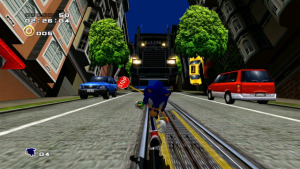
Interesting set pieces and small scripted moments in levels have been a staple in the Sonic series since the beginning. Sure, they’re not always challenging from a game-play standpoint, but they’re always an entertaining spectacle. One of the most ionic of these moments (and one of my personal favourites) is being chased by the GUN truck. City Escape is already a highly memorable level from the get-go, but the truck sequence is the cherry on top. An additional shout-out to both of the Generations versions of the level for not only bringing it back but changing it up just enough to surprise you and keep you on your toes!
9) Escaping Null Space
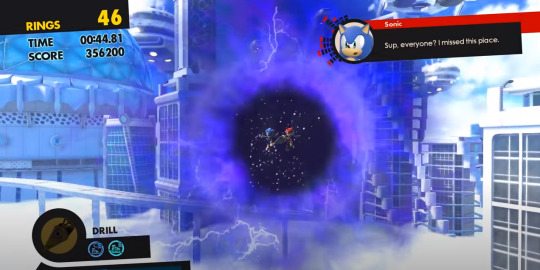
Forces is one of those games that I would describe as a truly mixed bag. Yeah, there are a lot of things about the game that kinda sucked or were disappointing, but when it hit a high, BOY did it hit. While I agree with many people that having the Null Space portion of this level actually have gameplay in it would’ve made this moment impact a little harder, I’m just in love with that transition from the silence of null space to the bombastic chorus of Fist Bump. I thought it was a really exciting moment that hypes you up for the rest of the level.
8) Sonic Heroes’ opening cinematic
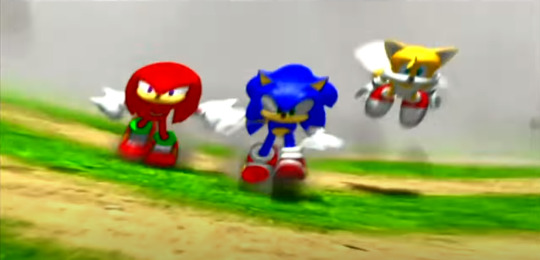
Heroes was my first 3D Sonic game, and consequently it was my introduction to a lot of things that are staples for the Sonic series. Vocal themes, an extended cast and their interpersonal relationships, story routes that connect to each other. These are some of my favourite things about the Sonic series, so even if some aspects of the game aren’t that great, I could never ever hate or even dislike Heroes. I feel like the opening cinematic to Heroes (the one with the theme song as the music) is the aspect of Heroes that really encapsulates those feelings best. I must’ve spent hours as a kid letting it play over and over again singing along to it.
7) Shadow the Hedgehog (2004) title screen cinematic

Before you laugh, here is where I must remind you that this list is extremely subjective and highly influenced by my personal experiences and memories. Ok now imagine this: you are a 7-8 year old kid, and your experience with media that isn’t mainstream radio or educational children’s tv shows is fairly limited. You’re getting deep into the Sonic series for the first time thanks to playing Heroes and seeing some of the cartoons and you’re interested to know more about the series. You visit Sonic Central, the official site at the time, and they have a music player with a variety of songs from the games. One of the songs it plays is I Am (All of Me). I won’t lie, I was a little blown away because I’d never really heard anything like it before, so I go to find out more about the game it’s from and I come across that opening cinematic.
I think it’s very, very, easy as an adult to laugh at the Shadow the Hedgehog game and it’s… direction, but adult me was not the target audience of that game, kid me was. Say what you want but the effect that game was going for I think is something that just hits best with sheltered little kids, and I’d be curious if anyone else had a similar experience.
6) The ending of Sonic and the Black Knight
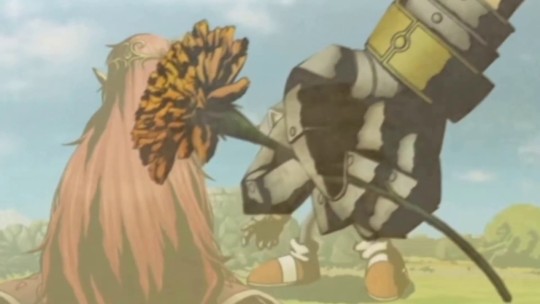
I won’t go into too much detail on this one, since this is very much a fan favourite moment and many others have gone into detail about why it’s so great. Black Knight is certainly one of the games that captures Sonic’s character the best, and his words at the end of the game certainly encapsulate this. Followed by the amazing credits theme of Live Life, the ending of Black Knight is certainly one of the most emotional moments in the series.
5) Sonic Generation’s credits
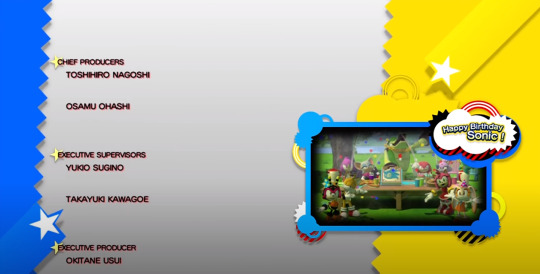
Anniversary games can be a bit of a controversial subject for the Sonic fandom; 06 was one of the games released for the 15th anniversary while Forces is often considered to be a 25th anniversary game. I think Generations really achieved the feeling and the specialness of a celebratory event though. It’s one of my favourite Sonic games and the whole game is full of brilliant moments but I feel the credits really evoke the celebration vibe: a Sonic 1-esque music melody as the credits song, showing footage from the original games each stage is from, and the cherry on top: a ‘Happy Birthday’ message to Sonic recorded from fans who attended the 2011 Sonic Boom and Summer of Sonic conventions. It genuinely warms my heart every time I finish the game.
4) Metropolis Capital City level
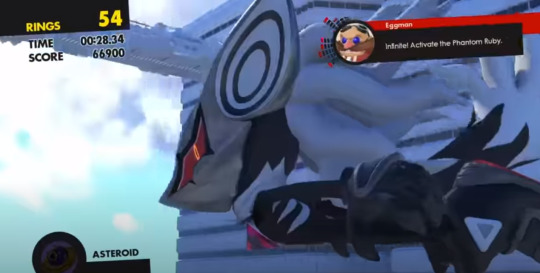
Forces gets another representation on this list! Honestly, I believe the parts of Forces that were exciting, such as this, really demonstrate my opinion that Forces had a lot of potential to be a really good game. But I digress, this was my favourite level from Forces because it shows how fun of a villain Infinite could be. The way that Infinite follows you for most of the stage and uses illusions to fuck around with the stage itself? That’s really fun, and it’s not just stage gimmicks for the sake of having a gimmick, it ties into the powers of the villain and makes the player feel involved in a way because Infinite is messing around with you specifically and is having to make to think on your toes. Granted, part of makes this stage stand out so much in a good way is because it’s so different from the rest of the game and it takes you by surprise, so maybe the impact wouldn’t be as hard hitting if this sort of design was used more in the game, but c’mon when you have a villain who’s powers are illusion-based, the sky’s the limit!
3) Sonic Unleashed’s opening cutscene
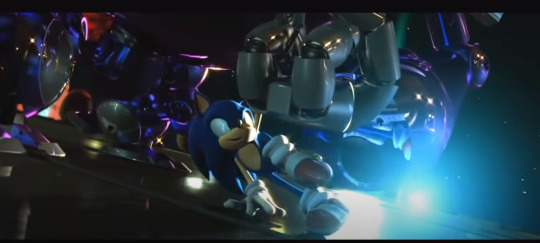
Can you believe this game came out over a decade ago and the opening cutscene still looks this stunning?! Depending on who you ask, some might even argue that this cutscene has yet to be topped, and honestly, I’m in that camp. Not only is the rendering beautiful and the choreography of the action exciting, but this scene does a wonderful job of setting up for the viewer regardless of how much prior experience they have with the series who Sonic and Dr. Eggman are, as well as setting up the events of the game. I recall being very happy when I heard the animation team for this cutscene would also be handling the animation for the movie.
2) Beating Sonic Unleashed for the first time
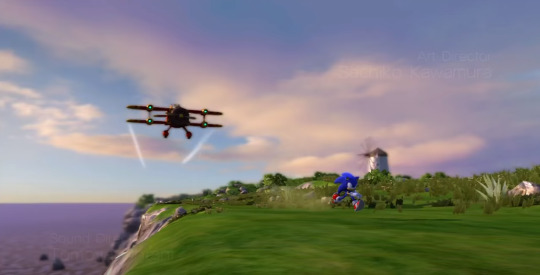
So, this is another pretty personal one. I played Unleashed for the first time a few years ago and it is in my opinion, one of the most difficult Sonic games. Sometimes intentionally, sometimes for completely bullshit reasons. My first ever run of Eggmanland was around 40 minutes long and apparently that’s considered a pretty decent time for your first go, but christ it was a nightmare to finish (looking at you, that one section where you have to platform on pipes without a drop-shadow). The following boss sections weren’t much easier- I don’t rage much with video games, I tend to whisper swears under my breath at most but that part where you’re running on the Gaia Colossus had me screaming in anger every time I lost a life.
BUT when I finally beat the difficult sections? Felt like finally cracking your back after feeling stiff all day. Like taking the first sip of water after a walk on a hot day. The relief and satisfaction I felt was indescribable and slowly winding down while Dear My Friend plays as the credits theme was blissful. I don’t play difficult games that often so Unleashed is one of very few games that I have this sort of memory with.
1) Watching my dad get the good ending of Sonic 1
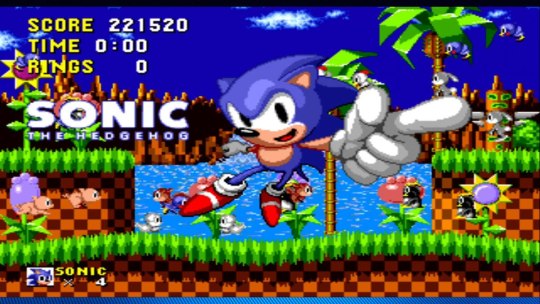
Here’s a small amount of backstory for this pick. My dad got his first job at 19 and he used his first pay-check to purchase the then newly released Sega Mega Drive. He had a lot of games for the console including Sonic the Hedgehog. He kept the console and games in good condition, and they were still perfectly playable by the time his first child was born (aka me!). Sonic 1 was the first video game I can remember playing at roughly 2-3 years old. I wasn’t good enough to get past Green Hill Act 3 but I loved watching my dad play through the game.
I’ll admit; his playstyle’s a little odd, he avoids speed when he can and instead, he likes to search for as many rings and extra lives as possible, but it was so enjoyable to watch nonetheless. The best bit was whenever he would manage to get all the chaos emeralds in a playthrough and be able to get the good ending. Sure, the only difference between the good and bad endings is just some flowers, but it was nice to see him be happy that he was able to achieve that ending.
And that’s the end of my list! Upon looking over it I realise most of it is either openings or endings to games…oops. I suppose they tend to be parts of games that get special attention during development since they bookend the journey. When I get around to making the second list, I’m sure it’ll have more variety, and as I said before, I’d be very interested in hearing what everyone else’s favourite moments are!
6 notes
·
View notes
Note
So... Did you hear about the new TWEWY game coming out yet?
Oooohhhh boy. Neo. I have heard about Neo, and I’m not happy.
Let me start by saying that Sho Minamimoto is my favorite character. I love him SO much. And every single reason for this lies in his villainy (no matter what a younger, more morality-obsessed me would try to tell you). This is a young rebel who decides he wants to fight God and rule over all dead people in this city. He asserts his dominance by chucking Dadaist trash piles all over the place and going “This is MINE because I put my TRASH here!” He’s an utter slimeball and that’s why he’s ENJOYABLE to me.
I do not see any of this magic being recaptured so long as he has to play nice with the hero team.
Maybe he won’t be redeemed. He could be the Token Evil Teammate – though that still wouldn’t allow him as much freedom and fun as his days of roping angels and the FORBIDDEN type of evil encounter monster into a grand conspiracy. Or he could be a Twist Villain, but let’s be real – modern media is never that obvious about who the twist bad guy is.
(Except No Straight Roads, which understood that a predictable Twist Villain is an effective one. ILSYM NSR. But that studio is considerably smaller than Squenix and can do what it wants, like allowing its voice actors to say a queer ship the fans made is good. Oh, I long for the day when a Squenix developer will actually validate even ONE of our gay ships in FF or KH.)
The other thing is that I only very recently just checked out A New Day’s scenes. Like, a week ago. Remember when I put up that edit of Coco Atarashi x Symonne from Tales of Zestiria? That’s the timeframe to mark. Listen. I grew up on old-school TWEWY on the DS. I never played any of the Remixes. So after seeing enough content of Coco on my dash, I was like “I should actually watch the epilogue that has this cool Reaper who pretends to be cute but isn’t” (an archetype I like a lot these days).
The thing about A New Day is that we live in a post-KHIII world, which kinda affects how I view all of Squenix. A New Day felt like KHIII levels of complication. Not like the “KH is complicated” jokes of old in which it was just long and had lots of continuity so people were like “This is too much to keep track of” (which it wouldn’t have been if they’d packaged the Remix games on the same console from the start, but I digress). As in how in III and the prequel/Daybreak era, Nomura and his crew have started throwing in alternate realities and time travel because they keep getting bored with the plot they’re doing now and want to make it something else. You know what else KHIII did a lot of? Villain redemptions. Vexen, who is even dearer to me than Sho, became not only a hero, but a hero who lost all of his personality. Most fanfics I’ve seen that deal with his redemption at least keep him in character to who Vexen used to be. But canon decided he doesn’t even have a personality anymore, and so you wonder why I’m worried about Sho?
Also to consider: the fact that KHIII insists on tying itself to TWEWY lore. I just want to forget the worst parts of that game, but canon won’t let me, the fandom won’t let me, and I’m SURE Neo won’t let me. Neo is going to remind me that Sora yeeted himself into the sun because one (1) of his friends was important than the entire collective of the other people who love him and it’s probably going to have to do with him running around somewhere.
Or it won’t. After all, there’s no hint of that. There’s also no hint it’s going to resolve the cliffhanger from A New Day. Neku is nowhere to be found, even though Sho was supposed to be his partner. Coco is nowhere to be seen. Sho’s existence and the naming of Hype-Chan are the only proof I have that AND is going to be followed up on at all (BTW, “Tsugumi”? Nothing objectively wrong with it; I’m just so deep in the DanganRonpa hole that I will constantly say “Tsumugi” by accident). And maybe the other stuff’s hidden because the crew is guarding spoilers, but those are all plot threads we very clearly expected as of AND, so there’s nothing to spoil if you cut your footage right. It seems so backward to me that we have to design a whole new crew of characters to take over the story to finish a plot that involves Neku somehow. (Though Nomura is designing them and again, he gets bored with what he’s doing so quickly and wants to move onto the next thing, which means he should really just start making different series or oneshots instead of trying to pack it all into one. TWEWY was best when it was a standalone thing with no worry of series rot.)
It also just feels unfair to me that it has this whole 3D battle system and OG TWEWY just got its 2D system in high-def. Maybe this is because a couple months ago, I was having a chat with a friend about “If you were a game developer, what would you do” and I came up with this whole way to translate the TWEWY UI into the stuff of a fully voice-acted and animated 3D game, and now Neo is halfway there, and obviously the OG could have been translated to this, but it hasn’t been, and you need to understand OG TWEWY in order to get Neo’s plot, so why can’t we streamline them both? REALLY remake OG TWEWY into something that matches its successor? I just love the story and characters of classic TWEWY, and I’d sooner see that all polished up on a new platform and made accessible to a new audience of gamers than just blowing on to a new cast and a plot that I’m really not sure will be good.
But in the end, if Sho Minamimoto is fun, I’ll be happy, and I’m afraid he won’t be. I’m afraid he’ll either go full antihero or be diluted into “evil, but only in his words” by the ball-and-chain of the party around him. Oh, and did I mention I’m gonna be real mad when we eventually have to deal with how Sora fits into this?
I do really, really love Sho’s new coat, though. Like…an insane amount. I might actually reblog fanart of him in that coat if people are drawing it because as much as I am not excited for this game, the costume design is already gorgeous.
4 notes
·
View notes
Text
Ajin: Demi-human (season 1) Review
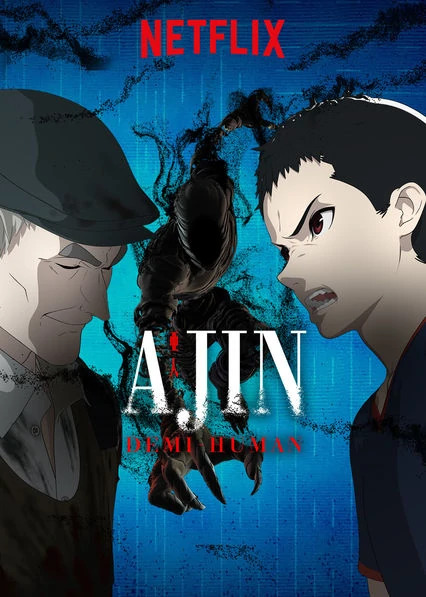
THIS REVIEW WILL CONTAIN SPOILERS
Oh my goodness was this a slog to get through, Three days people, it took me three days to get through 13 episodes Because OMG Setting aside the fact this is some of the ugliest 2d to 3d rig work I have ever seen, I have never seen a show have some much going on with out achieving anything. Ok ok ok let me start this properly.
In the world there are being known as Ajin, these Demi-human beings are rare with only three known cases in Japan, the Ajin are capable of resurrecting from fatal wounds making them Semi-immortal, they also have the ability to summon being known as ‘black ghosts’ which can be used for all sorts of things. There is unfortunately no way of knowing if a person is an Aijin until they suffer some for of mortal injury at that point their body will regenerate and they will live this is the case for Kei Nagai, a high school student studying to be a doctor. While the government of Japan have led people to believe that Ajin are kept in protective custody it is learned that not only are they but most other countries use Aijin as test subjects for medicines and weapons, including life fire testing, because of their regenerative abilities.
Story time
17 years ago during a war in an unnamed African nation the first Ajin was discovered. Reffered to as a soldier of god because he could not be killed the soldier was immobilized and claimed as property of the US government.
Now Kei Nagai is an apathetic highschool student studying to be a doctor on his mothers demand. While to his ‘friends’ he seems like a cheerful if easily taken advantage of boy the truth is he is apathetic and cut off from the people around him seeing only the value they have to him personally. While walking to school he and his friends note another boy their age Kaito sitting outside a convenience store they comment on how weird he is and question if Kei is his friend after Kaito waves to him, Kei denies this and they walk on.
At school the subject of Ajins is brought up because of their value in the medical feild, one of Keis friends shows another classmate a video of Inhumane testing on an Ajin subject. The boy also asks his teacher if the truth about the high reward for an Ajins capture is true. For some reason this startles Kei and his reaction draws attention so he asks if Ajin aren’t really human. His teacher says they are not.
Reminiscing he vaguely remembered the death of a childhood pet, after burying it while trying to console his sister he wonders about death and witness’ something strange. curious about the memory he decides to visit his sister in the hospital and tries to ask her about what she remebers but she refuses to discuss it being outright hostile to him.
still lost in thought and wondering about Ajin as well as flicking through Study cards Kei misses the stop light and begins to cross the street before being hit full on by a truck. the truck drags his body quiet a ways as it skids to a halt and his friends are horrified by what they’ve witnessed, the driver is shaken and climbs out desperate to say that it was Keis fault when to their shock Kei crawls out from under the truck dazed t first he is confused about what happened before quickly realizing and becoming upset he insists he’s human and begs for his friends to believe him however he realizes they only see him as a way to make money by turning him in. in terror Kei screams unintentinally releasing his voice, another unique trait of Ajin that causes a temporary paralasis in those who hear it, before fleeing the scene.
a little later Yu Tosaki and his body guard and assistant Izumi Shimomura of the Ajin control branch of the government arrive to question Keis friends and his mother. As this is going on it is revealed that Kei has fled to a local Shrine and then into the woods beyond, desperatly thinking who might help him he remebers Kaito who had been a childhood friend but whome he’d been told not to be around anymore by his mother. Desperate and worried Kai Might also want to turn him in but feeling alone Kei calls Kaito and the other boy is ready to help his friend filling a duffle bag with supplies and heading out, knocking out a poliece officer who had found Kei Kaito offers his old friend a hand up and they flee the area on a motorcycle.
The Bad
Despite how much I’ve written that happened in the first episode. it not actually a lot. theres a lot of nothing in this show and thats a major problem. I a not against quiet moments, for example Hiyao Miyazaki is very well know for his long silent scenes, but even these scenes serve to tell story in one way or another, I get the feeling either the writer or director of this show wants to emulate that but the quiet scene in the show just don’t accomplish anything. theres also a sense of ‘artistic padding’ where things are added for the art of it, I don’t know if someone in the production team had higher aspirations or if they where just desperate to cover the ugly modles but it doesn’t work.
The episodes feel long but almost nothing happens. or a lot happens but none of it matters or is memorable. The motivations of the antagonist make no sense, and while I have a theory of who he truely is I won’t say untill I do my reviw on season 2 (Which won’t be for a while because this was so hard to sit through)
Kei himself is a terrible protagonist, there are moment whre you think he’ll get better, but he really doesn’t in fact I thought the show was going to pull some kind of switch and make the story focus on the friend Kaito who seems to really genuinely still care about Kei even though they hadn’t been friends for years and who insists even if Kei is an Ajin, he’s still Kaitos friend so that’s all that matters. But Kei leavs Kaito after only a couple episodes
It’s clear that there is something not right with kei from the get go, the first time we see his phone all his friend are listed not by name but number literally ‘friend 1′ ‘friend 2′ and so on, and as the show goes on theres an impression that the creators where trying to make Kei a Psychopath. I’m not talking Ax wielding movie psycho but a clinical psychopath, no empathy no connection to the people around him, a general callous nature and his willingness to use then abandon anyone who might have value. I’m not a fan of using mental illness as a way of making people ‘other’ mental illness is demonized enough, and frankly it’s hard to empathize with a protagonist who openly admits they don’t care about anyone.
There aren’t any real stand out characters either, they all feel like cut outs, you have you deceptively friendly antagonist, you have your to serious government agent, and his body guard who obviously has a crush on him, you have the best friend, you have the friendly granny.
It’s just all been done before and better.
Now about episode 8 a character name Ko Nakano is introduced and for a moment I thought Oh the shows just going to give us a new protagonist... NOPE! he get capture by Kei who keeps him locked in an old shipping truck for the rest of the season, Fuck that noise. honestly Kei gets less and less likeable as the show goes on. He abjectly refuses to get involved with trying to stop the antagonist, Sato’s, terrorist plot even saying openly he doesn’t care what happens to other because he’s found a nice place where he can live a quiet normal life. Kei had in fact been taken in by a kindly older woman who convinced the villagers kei was her grandson from tokyo who had gotten into trouble and was staying with her.
That being said.... There’s a couple good things
The elderly woman is quiet charming, she doesn’t care about the Ajin or what ever other trouble Kei seems to be in she just sees a young man who helped her after she fell and lets him stay. If not for another villager recognizing his picture on the news and reporting him to claim the rumoured reward Kei clearly would have been happy to stay in that little village forever and just live a quiet life.
The opening theme song is pretty good. the CG is frustrating in that in the opening they show shots of characters as they looked in the manga and those drawings are amazing, This would have looked so much better 2d Animated.
The black ghosts are kind of neat.
theres a couple interesting fights with the Ajin, since they recover almost instantly from death they’ll actually kill themselves in combat to resurrect with out their injuries or to even escape grapple or escape the effects of tranquillizers, so that’s neat
I haven’t got much here guys I’m sorry I’m trying but this just, I feel like there might have been something good under all the thick thick thick padding.
Final Thoughts?
I don’t recommend it, even for one watch it’s just a slog, it’s not enjoyable it’s not even a good time killer because it feels like it drags.
Everything from plot point to characters to scene have been done before in better shows, and the aesthetic is just Ugly, terrible CG modles with awkward round movements to avoid collision issues clearly, and the backgrounds look like someone took photos and then put them through the photoshop watercolor filter.
There’s nothing worth reccomending about it, I know Netflix has stuff way better then this so go watch that because this so Not worth your time.
#anime#anime review#Netflix#netflix review#Ajin#ajin demihuman#ajin demi-human#reveiw#So not worth it
5 notes
·
View notes
Text
Nintendo Nostalgia Nintendogs

Talk about a blast from the past, I was cleaning my room today and came across my Nintendo DSI. Now keep in mind it’s completely normal to find video game consoles literally everywhere. I consider myself a console collector and I’m super proud of it. Most of my concosles are from Nintendo I specifically loved all of their handheld consoles. I’m always on the go and have been my entire life so it just makes sense for me to have consoles that I can take with me on the go. Anyway before I diverge off the beaten path of this post...
The game that was inside of my Nintnedo DSI was the original Nintendogs game Nintendogs Dauchsund and friends. So, naturally when you have a sense of nostaligia with a video game what do you do? you play it. That’s exactly what I did I stopped cleaning for a full hour just to go in and play with the puppies I haven’t visited in years. What’s super sad about this is this gives you actual emotions so it made me feel like I abandoned them for so long. The connection was far to real when I started to play the game again. I didn’t know how much I truly missed the original game. Keep in mind I do have the 3Ds game but it’s not the same. There’s something about the original that just doesn’t feel right about the “newer” version.
Below is my story about my first video console bought specifically for me which was the original Nintendo DS and the Nintendogs game. I really hope you’ll read it. It’s just a sweet memory I wanted to share with all of you. Just press the “keep reading” button below.

My Story Receiving a Nintendo DS (original) With the Nintendogs Game:
I feel like for a little bit of time I’m going to be playing it a little more. Not that I don’t have my own real life pets that I love and adore. But keep in mind I had the original Nintendo DS with that particular game. It is a HUGE part of my childhood and it brought back so many amazing memories. I won’t forget the day I had a best friend at the time we’ll call her Alex (not her full name). She had a red original Nintendo DS with the Chihuahua and Friends Nintnendogs game. I’ve never seen anything like it. This was my first time ever seeing a video game console outside of a Sega Genisis system. I was amazed! there was a touch screen. I was very much shielded as a child which isn’t always a bad thing but wasn’t a great thing either.
My friend asked me if I wanted to borrow it and bring it back the next day. Which might I add was the beginning of my insomnia. Thank you Nintendogs. Ha-ha. I was so excited and of course didn’t pass it up I told my mom I was borrowing it so she would know and I played it literally all night. The next day came and I brought it back as a kid this was one of the best nights of my life. So what did I do? I’m not particularly self motivated I was in 4th grade and I failed the FCAT reading (state standardized test at the time) in 3rd grade. So, I said to my parents if I pass the FCAT reading this year may I get an original Nintendo with the Nintendogs game. I didn’t want anything else. My parents at the time would do anything for me to just pass these standardized tests that no matter what I did I just had the worst time. I even had extra time on them.
What did I do? I passed the test! I remember the night so vividly we went on either the Walmart or Target website during the holidays. There was a bundle one specifically with the game and the DS so they told me to go over and choose everything quickly before they sold out. I did. I was so excited this was my first time getting a video game console and video game that was mine. This was the beginning of my console collection and every few years I saved up the money or worked hard for a newer console when I could. I was never handed anything to me on a silver platter I’ve worked hard for everything I’ve done and received. To be fair I also never really asked for a whole lot and appreciated a lot of what I had. So when I did go to my parents for something I’d ask “What could I do? or what would it take for me to get _____ for my birthday, holidays, passing tests, etc?”
Finding my Nintendogs game brought back so many memories to me today. I had to share it with all of you. I hope you enjoyed my story. Let me know what your first console and video game you’ve ever played was. I’d love to hear it.
Until next time...
Ellie
#nintendogs#nintendo#storytime#memories#bittersweet#sweet#sweetmemories#video games#videogames#video gamer#videogamer#gaming#virtual pet#virtual#pet#virtualdog#virtual dog#Nintnedogs video game#NintendoDSI#Nintendo3Ds#Consolestory#console story#firstconsole#first video game console#interests#hobbies#consolecollector#collection#collector
6 notes
·
View notes
Text
Famitsu #403: Hideo Kojima interview (Metal Gear Solid)
The following is translation of an interview with Hideo Kojima that published in Weekly Famitsu #403 (September 6, 1996). A second part of this interview was published in the following issue, which would be be Famitsu #404 (September 13, 1996), which I currently don’t have access to, but I’ll post my translation if I ever get a hold of it one day.
This interview was conducted shortly after the game officially unveiled to the public in late 1996 and touches upon some ideas that did not make it into the game.
Metal Gear has a special feeling
Metal Gear is quite an old game. Why did you decide to make a sequel after all this time?
Hideo Kojima: Metal Gear came out in 1987. Has it really been ten years? The truth is that Metal Gear was actually the first game that I’ve made when I’ve joined Konami. There’s that emotional attachment, as well as a feeling of tension of “being seen or not by the enemy” that was characteristic of Metal Gear that I wanted to explore further.
For example, let’s say your character hides under a desk. When that happens, the point of view changes to under the desk and the nearby soldiers will walk around making noises. Or you hear the footsteps of a soldier, so you quickly hide inside a locker to avoid making noises. I wanted to express that kind of tension. I had the same concept with the original Metal Gear, but I wasn’t able to express it with the hardware available at the time. However, we finally have a 32-bit console capable of using many polygons, so I can finally do what I wanted to.
So you had the idea for over ten years?
Kojima: Yes, that’s right. But I started working on it a bit late since we did Policenauts first. (laughs)
It seems there are a lot of things you can do with the current 32-bit consoles that couldn’t be done with the older hardware at the time.
Kojima: At the time I wasn’t thinking of 3D, so I did the best I could under those circumstances. Since 3D is possible, on one hand you can now do this and that and anything, but in contrast everything is now harder to make. (laughs)
So will this new Metal Gear game serve as a conclusion to the previous games?
Kojima: It’s a new type of Metal Gear. To be honest, I don’t think most modern players are even aware of the original Metal Gear. So I wanted to remake Metal Gear so that people could play it again. (laughs)
Can you explain in detail what kind of game is it?
Kojima: It’s a polygon-based 3D action game. The basic idea is to infiltrate an enemy fortress where guards are roaming and you must proceed while avoiding being spotted by the enemy as much as possible and avoid all sorts of traps.
It doesn’t sound a flashy game where all you just shoot stuff.
Kojima: That’s the idea. If you get spotted by an enemy, he will called for backup with a radio or something. However, if all you do throughout the game is just hide from the enemy, then it’ll be quite a stressful experience, so there are instances where you must fight a boss-class enemy in a fancy showdown. I wanted to keep a careful balance between tension and combat.
Sounds similar to another game that became a hit recently.
Kojima: Comparisons to Resident Evil seems to be unavoidable based on its appearance. (laughs) However, I think you will experience a completely different sense of heart-pounding excitement in Metal Gear Solid. There won’t be such thing as having to readjust to the controls because the perspective has been changed. Basically your perspective remains the same throughout the game and your character will always go up when you press up on the directional pad. I wanted to realize a simple and efficient control system for players who have never played a 3D game before without making them feel out-of-place.
Menu-driven or action-based? That’s the only difference
Can you tell us a rough outline of the story?
Kojima: The hero of the game is a mercenary named Solid Snake, who also appeared in the original Metal Gear and its sequel Metal Gear 2. The setting is a nuclear weapons storage facility owned by the U.S. military located in Alaska that has been hijacked by special forces group called FOX HOUND. That’s the reason why Snake has been sent there. From his perspective, it’s a battle between himself and the members of the special forces group he used to belonged to.
So you’re saying there will be an element of human drama involved similar to the ones in Snatcher and Policenauts...
Kojima: That’s right. I’m very obsessive when it comes to making such things. In other words, Metal Gear Solid is pretty much the same as Snatcher and Policenauts, even if the method of unraveling the story is different. The themes I want players to feel is the same whether the story is unraveled by action-based gameplay or by navigating through menus. However, I think the players is able to empathize more if there is some action-based gameplay. On the other hand, action-based gameplay alone will get in the way of the story, so regulating that is difficult.
In other words, finding a balance between the action-based portions and the story you want to show is pretty important.
Kojima: Having to adjust that balance seems to be the most difficult part. I want to use movement and camera work well and show things without feeling out of place. I want to show for example, a startling movement that causes a sudden noise, naturally in one flow. While we use motion capturing, we also have a staff member who worked as an animation for almost a decade and his handmade animations is pretty nice too. You can create something nice if you know how to use these things well.
Regarding camera work, the composition will not change much and we will frequently employ cinematic techniques in which the camera moves in or away. Pre-rendered videos won’t be used much. We might used them to cut-in an image, but the actual events will be rendered in polygons. For that purpose, each character will have around 3 or 4 models.
Can you explain that?
Kojima: Suppose you’re projecting a character from a distance. If the camera moves closer to the character, the character model will become rougher as its gets close. In order to avoid this, we replace the character model with a version that has more polygons as the camera approaches the character. This is a technique often used in movies for visual effects.
You don’t want to interrupt the flow of the game as much as possible.
Kojima: The more realistic your worldview is, the more important such a thing will be. But pre-rendered videos have their merits too. You want to throw-in a video because it’s easier to express subtler effects that way.
What kind of world are you building with that much attention?
Kojima: I wanted to make a hardboiled world. And I wanted to demonstrate it as entertainment. Since we use war as a motif, there’s some heroic parts. You have your guns blazing, shooting at bad guys. You are cool, you are a hero, you’re that sort-of guy. However, if all that remains are just stuff that was cool, then I really wouldn’t call that “entertainment.” I want players to be conscious of what war means and what is a nuclear weapon by the time they’re done watching ending.



22 notes
·
View notes
Text
Strategy Games: A Blueprint for My Life
Strategy video games are near and dear to my heart. My childhood was full of long nights playing Age of Empires II, Empire Earth, and Civilization III. Later, when my friend’s older brother decided we were mature enough to appreciate one of the greatest in the RTS genre, we were introduced to Starcraft. We might have been too young to appreciate the great works of art these games were, but we played them with as much dedication and energy as any devoted fan. Whether it was two boys sharing a computer while arguing over tactics, or a LAN party in a basement, we were always ready to sink an entire night into one of our favorite games.
As we matured into adults, so matured our video games. Gone were the days of dial-up lobbies with terrible ping. We now stared at HD graphics with mind boggling telescopic zoom in Supreme Commander. Our little pixelated troops became fully developed 3D personalities in Company of Heroes. Flat empty maps became grand 3D environments in Homeworld. These strategy games showed us that a good game is like fine wine, it only gets better with time. Maybe that explains why Age of Empires II came out with a remastered HD edition 14 years after the original release and became one of the top selling games of the year and one of the most played RTS games every year since its re-release. (It then re-released again with 4k graphics 6 years after that and topped the sales charts).
When college came around, it provided a new hurdle to gaming with friends. The early 2010s transformed into Hamachi virtual game lobbies from all over the US. Summers became LAN parties at our houses. A cheap $10 switch with a half dozen ethernet cables became the lifeline to play with minimal lag. My Black Friday laptop, affectionately known as “The Paper Weight” for its mediocre performance values, managed to somehow stay alive for 3 years of incessant, rough use. Age of Empires II was still one of our main games, but we had slowly transitioned to bingeing Company of Heroes most nights. We realized at this point that consoles would become an afterthought for us as the metamorphosis to the “PC Master Race” left us forever enamored to maxing framerates and CPU performances. We learned the value in studying game mechanics and watching pro matches to improve ourselves and outsmart each other. We developed out of our blissfully ignorant Dark Age and grew into our Renaissance Era in video games. Rapidly we each painted our unique gameplay styles with such fervor and individuality that even Leonardo da Vinci would be proud.
After a few strong years our Golden Era started to wane. I joined the military and traveled the world, my fancy new gaming laptop often left untouched for days—or even weeks—at a time. Some friends went to graduate school and became so absorbed in their studies we wouldn’t hear from them for months. Professional careers and long-term relationships started to replace long nights learning new tactics and fine tuning our early game build strategies. The endless nights of trash talking and meticulous ledgers recording personal and group bests, overpowered by the chaos that is life. We still played the occasional games here and there, but it wasn’t the same. It had devolved into two friends passing some time and catching up, not four or five allies that boldly created empires and destroyed civilizations. The Golden Era of video games had quietly come to a close.
Our Golden Era may have ended, but that doesn’t mean our history has disappeared. These games created a time-honored bond between friends. The patience and critical thinking skills learned from our many gaming sessions gave us vital skills for us to use in our careers (I personally thank these games for my ability to effectively manage many different tasks at once). I’m happily married to the greatest man I’ve ever met, but I still find time to occasionally play online with my friends. My husband knows that an hour or two planning attack formations and discussing economy planning gives me a form of stress relief and camaraderie you can’t find anywhere else. We love exploring the world and starting new adventures, but some days all I really want is a headset, a bourbon on the rocks, and a great strategy game. My friends and I developed a culture so unique that we are still inseparable 20 years later. Some people may look at this as a bunch of nerds wasting away their lives, but we were making memories and friendships that would last a lifetime.
~Shane Battles
#strategy games#age of empires#starcraft#homeworld#homeworld 2#company of heroes#company of heroes 2#pc#lan party
2 notes
·
View notes
Text
Vae Victis! – A Look Back at Blood Omen: Legacy of Kain

It was the mid-1990s. We were in the fifth generation of video game consoles, and gaming as a medium was eager to prove that it had grown up.
This had been going on before the fifth generation, of course. The Sega Genesis sold itself on its contrast to the status quo. “Sega does what Nintendon’t,” and all that. Sega’s whole image was bound up in being the cool kid, the one who’d outgrown all those pokey “kiddie” games like Super Mario Bros. or Kid Icarus or Mega Man. Sega fans played games like Mortal Kombat and Eternal Champions. Even a mascot game like Sonic the Hedgehog had a kind of snide adolescent streak to it; leaner, meaner, and less patient. Nintendo themselves had to butch up a little, even. When their bloodless version of the first Mortal Kombat got outsold by Sega’s, which kept all the gore – despite otherwise being technically superior in every measurable way – they relaxed their standards and left all the blood and fatalities intact for the second and third games, and saw a jump in sales accordingly.
The 90s were in part a decade of cynicism and ironic detachment. Sincerity tended to be frowned upon as being kind of silly and naive, or else a cover for motives less savory. Strong skepticism was the default mode, and in fiction, anti-heroes were all the rage.
Which brings us to Blood Omen: Legacy of Kain, described by its developers as a Legend of Zelda “for adults”.
Of course, any self-described adult who can’t bear to play a Legend of Zelda game because they feel it’s not grown-up enough needs to sit down and re-assess their idea of adulthood, and how secure they are in it. If a tolerance for violence (if not a craving) is all it takes, then I was an adult at about eleven, when I was single-handedly mowing down whole armies of Nazis in Wolfenstein 3D.
But those were the times, and that’s how Blood Omen got pushed. Which is unfortunate, because it misses the more thoughtful parts of the game’s story that actually did make it material mostly for adults.
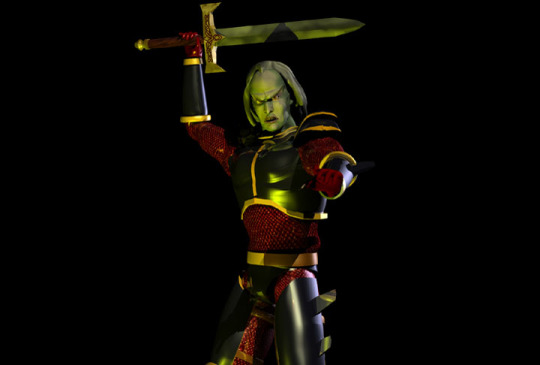
“...the first act in my theatre of Grand Guignol!”
We begin in the world of Nosgoth, and if there’s a made-up fantasy word that screams “dark supernatural fantasy” more than that, I haven’t heard it. Our main character is Kain, a nobleman caught out at night in a town where he can’t find an inn or tavern to stay for the night. He is cornered by assassins and murdered, whereupon he goes to hell. Or at least, we can assume it’s hell; I don’t think even a death metal band’s idea of heaven involves being cuffed to twin posts overlooking a literal lake of fire with a sword stuck through you. Anyway, that’s where Kain is, cursing the fact that he can’t get revenge. Which seems a little warped, on the surface of things. You’d think if you were stuck in hell, then getting out, however impossible, might seem more important than getting back at the people who killed you. But if you’re the kind of person who winds up in hell after being murdered, I suppose it stands to reason that your priorities may not be in order.
While Kain is in hell, lamenting his impotent rage and generally ignoring all the fine mid-90s CG scenery, he is approached by a necromancer named Mortanius.
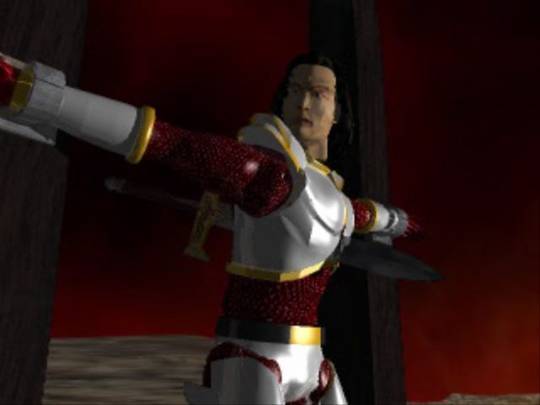
The necromancer offers him a way back to the world of the living, and thus a chance at revenge. Eager to oblige his overdeveloped sense of wrath, Kain takes him up on the offer, and fails to consider that there are only a few different ways, traditionally, that a dead person can cross back through the veil. And none of them really involve returning to life exactly as you were.
Kain rises from his grave as a vampire, stronger than he ever was in life, and only too happy to hack up his assassins when he encounters them not far from the site of his crypt. However, as he comes down from his vengeance-high, he hears a voice in the back of his mind – Mortanius’s voice, in fact – suggesting that his assassins were “the instruments of your murder, not the cause”. Mortanius then urges him to seek out the Pillars to find the real reason for his murder, and its true culprits.
We need to rewind a bit.

IN THE BEGINNING, there were the Pillars of Nosgoth (in fact, “Pillars of Nosgoth” was the game’s working title for a while). Rooted who knows how deep in the earth below, and reaching up to the clouds, the Pillars are a structure that should be physically impossible. They are somehow both integral to the natural order of the world, and also the embodiment of certain elemental principles. There are nine of them, embodying – in no particular order – conflict, energy, states (of being, not political), dimensions, death, nature, time, the mind, and balance. Each Pillar has its guardian, a human endowed with powers according to the Pillar’s defining principle, and tasked with overseeing that Pillar’s particular province.
A good while back in the past (how long is not detailed in this game, but probably centuries) there was a genocidal crusade of sorts against vampires, who were evidently a serious scourge of some kind. In fact, the game opens on a view of a field – practically a forest – of stakes, with a vampire impaled on each. Vlad Tepes would be proud. This crusade was ordered by the Circle of Nine (the collective group of Pillar guardians), and carried out by the fanatical religious order known as the Sarafan Brotherhood.
Monsters that they are, the vampires did not take this well. One of their number, an elder vampire named Vorador, decided to strike back. Vorador was by this point in his unlife no longer quite human looking, with mottled grey skin (later series installments would make this varying shades of green), odd three-clawed hands, and giant bat-like ears. Blood Omen never elaborates on the reason for this difference. At any rate, he singlehandedly stormed the citadel of the Pillar guardians while most of the Sarafan brotherhood were away (presumably looking for more vampires to stake), and wound up killing several of them (one of the sequels gives the number as six). In the process, he even managed to beat down Malek on his way out, perhaps the greatest warrior among the Sarafan, and the one specifically tasked with safeguarding the Circle.
For screwing up his one job, Malek was punished by being made to do that job for eternity. It might seem inadvisable to take the guy who failed to guard you and then make him your guard forever, but it helps if you rip his soul out of his body and bind it to his armor, thus making him a sleepless, tireless, unfeeling, and ever vigilant warrior fueled by pure wrath. Which is what they (or rather, Mortanius) ultimately did. At some point between this time and the present day of Blood Omen, Malek became the guardian of the Pillar of Conflict, so evidently he was fit for his role in the end.
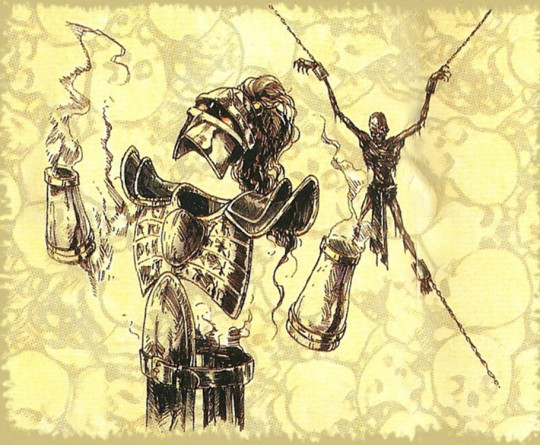
Now we fast-forward a bit, to a point just moments before Kain’s birth. In fact, later games place this at the exact moment of that birth.
Somewhere around thirty years before Kain’s murder outside a nameless tavern in a random town, Ariel, the guardian of the Pillar of Balance, is murdered. This is bad news for all the usual reasons, and also one or two unusual ones. It turns out that her lover is the guardian of the Pillar of the Mind, the mentalist Nupraptor. Her murder drives him insane, and being a telepath (among other things), his insanity infects the guardians of the other Pillars as well. This turns them from their usual purpose of upholding the natural balance, and instead sets them to destroying it. This in turn corrupts the Pillars, symbiotically connected to their guardians, turning them from pristine white to a pitted and cracking grey. With both the Pillars and their guardians respectively corrupted and insane, the natural order of things begins to fall apart. Bad news all around.
Blood Omen is somewhat unusual in that it’s one of the few probably rare instances in fiction where a woman is stuffed into the fridge at the beginning of the story, and in order to drive the villain to extremes of behavior.
So.
Now we have Kain, in the present of our story, given to understand that his death was in some way connected with the Pillars and their corruption. He makes his way to the Pillars, where he meets Ariel’s restless spirit. She’s the one who lays out for him part of the business about her murder and Nupraptor’s madness, and the threat posed to the world by it all. Kain is only interested in a cure for his vampirism (now that he’s had his vengeance, he wants no part of this undeath business), but Ariel persuades him that his best bet is to deal with the corruption of the Pillars. So Kain storms off to go take care of Nupraptor, and ultimately to cleanse the Pillars by severing their connection to their now-insane guardians, solving the problem of their corruption by reference to his sword. Go with what you know.
It’s at this point that Kain’s personal arc begins to unfold, as he becomes increasingly alienated from humanity, both the species and the concept. While initially at odds with his vampirism, Kain spends the story coming to grips with the hypocrisy and corruption of human civilization, all the while becoming more and more comfortable with the seeming monstrosity of his new existence. This is a matter of some necessity. He has things he needs to do, he has to stay alive to do them, and so a certain amount of blood-drinking and slaughter seems inevitable.
In his travels, he comes across Vorador’s manor, situated deep in a swamp teeming with monsters. Kain seeks his help to destroy Malek. Vorador, for his part, spends the encounter being lordly and largely dismissive of Kain’s quest. He advises the fledgling vampire that meddling in mortal affairs is nothing but bad news. Better to sit back and sate one’s hunger – or thirst, in this case – and let the mortal world turn as it will. Humans are to be preyed on, not helped or manipulated or otherwise gotten involved with. Best to stay above such passing concerns. Nevertheless, he takes a liking to Kain, and gives him his ring to summon him at need.
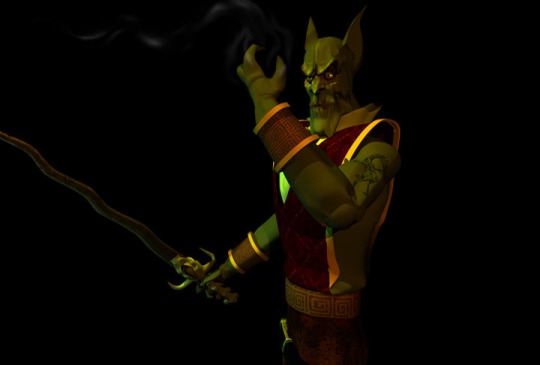
Say a word often enough, and it starts to lose its sense of meaning. Actions likewise lose significance with repetition. They become rote. And as time wears on, Kain seems to begin making a turn. There’s a certain honesty in being a monster. You always know what you are, and you always know how other people see you. Kain may sneer at Vorador’s decadence when they meet, but at least the elder vampire is never less than one hundred percent honest about what he is.
And as Kain goes on, it begins to seem that Vorador was right. So much of Kain’s and the world’s difficulties seem to stem from the selfishness, greed, shortsightedness, self-absorption, and general malice of the people he runs up against. Eventually, he winds up accidentally sparking a second genocidal crusade against his own kind. This has mostly to do with him traveling back in time to kill a man in the past who would grow to become a tyrant in his current era. This mistake no doubt has its roots in his not having not grown up in a world with a whole sub-genre of fiction concerned with the merits or otherwise of traveling back in time to kill Hitler.
We will have such fun with time travel as the series goes on, let me tell you.
The game ends by offering the player a choice. Kain’s efforts to cleanse the Pillars and restore balance to the world have made him the new guardian of the Pillar of Balance. Yet, like all other Pillar Guardians slain at his hand, he himself is corrupt, and must die to complete the task. So the player is asked: Will Kain willingly sacrifice himself for the greater good of Nosgoth, or will he refuse the sacrifice and choose to live in an increasingly broken and corrupt world.
The sequels take the second ending as canon, and honestly, it’s hard to argue. This isn’t a story about hope springing eternal, after all. The few people in it who are unambiguously good are either killed (Ariel) or largely ineffectual (King Ottmar, who comes to prominence briefly toward the end of the story). The player may feel differently, but there’s little reason to believe that Kain would. Proud, haughty, vindictive, wrathful, and growing ever more cynical and mistrustful of the motives of those around him, tired of being used as a tool for other’s schemes... Why would he choose to sacrifice himself?
And so, canonically, we close on a shot of Kain sitting on a throne at the base of the Pillar of Balance, with it and all the other Pillars lying in a broken ruin around him. He drinks from a goblet, and muses that Vorador was right after all: “Vampires are gods – dark gods – and it is our duty to thin the herd.”
The End.
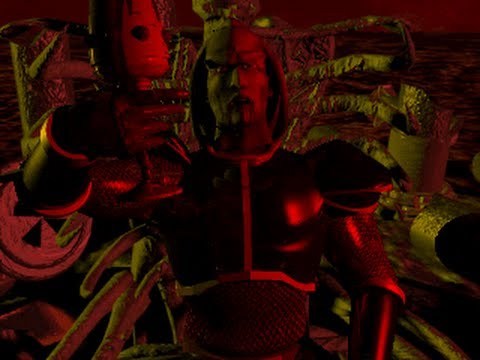
“Nothing is free. Not even revenge.”
So that’s Blood Omen as a story. What about as a game?
On the balance it’s kind of uneven.
On a technical level, it’s fairly impressive. In its time, it stood as a testament to the potential quality of two-dimensional graphics in gaming, even as the entire medium was leaping into the third dimension, ready to ditch and decry anything made in 2D as inferior. The result from a technical standpoint is that Blood Omen has in some ways aged better than a lot of other games of its vintage, including its first sequel.
But then you actually play the thing, and see where it sort of falls apart.
Let’s get the easy part over with, shall we? The load times in Blood Omen are godawful, just the worst possible combination of long and frequent. It seems almost like a joke at times: “Really? We’re loading again? It was one fucking room!” Were it not for the fact that it began development as a totally unrelated game, I would strongly suspect that the sequel, Legacy of Kain: Soul Reaver, used its data-streaming technology to avoid loading times altogether purely as a response to this criticism. I still think that may be the case.
Once we dig past the issue of loading times, though, the game reveals other issues.
There are good ideas on display here. Let’s start with that. The game has a day-and-night cycle, and while you can walk around during the day, you deal less damage (and take more) while the sun is up. Water is like the touch of acid to a vampire, and any time you’re in it, you’ll take constant damage. Rain and snow will likewise damage you, and while there are power-ups that are supposed to eliminate this problem, I’m not sure they actually work. At least, not on the PC version of the game, which is what I’ve mostly played.
The game also requires that Kain drink blood periodically. His health naturally drains very slowly, but constantly, so you always have to be on the lookout for a way to top yourself off. There are some more abstract health restoration items, as well as a consumable item you can use, called the Heart of Darkness (this item will become obscenely important in later installments). However, the game is structured such that most of Kain’s health restoration will have to come from either enemies or, more often, helpless innocents. This ties nicely into the game’s theme of alienation from humanity, though the way the game often presents these situations –random strangers chained to walls all over the world, for no apparent reason – seems a little odd at times. And it has interesting ideas about different creatures having blood that might actually be harmful to Kain, or inflict him with a long-term poison.
In addition to the graphics looking nice (the CG cutscenes are definitely of their time, but the in-game sprite work and lighting effects are quite nice), the game has a great soundtrack, dark and moody and ominous. And the voice work is superb. All character interactions are handled with voiceover rather than on-screen text, and the cast knocks it out of the park. Not just “good for the mid-90s video game voice acting”, but great, period.
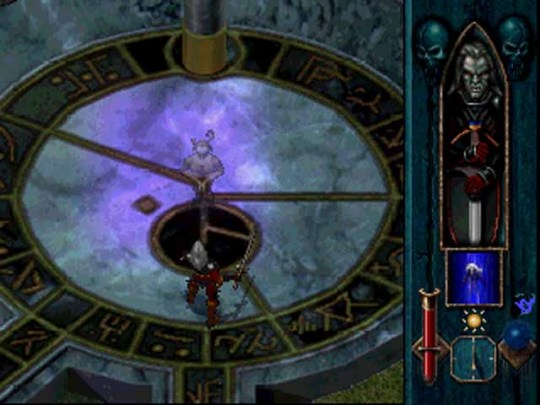
The puzzle-solving is a little lackluster, though. For something pitched as a “grown-up Legend of Zelda”, its puzzles largely consist of pulling levers and pushing buttons, and navigating mazes. Which is fine, but again, any game that’s going to self-consciously compare itself to The Legend of Zelda needs to bring its A game, especially with its puzzle-solving.
The game does offer you a lot of tools to use, in the form of different weapons, spells, and magical items. But a lot of these boil down to more inventive yet questionably practical ways to kill enemies. And considering that setting up a selection of these items for immediate access involves going back and forth to the inventory menu (requiring a load time both ways), it’s easier to just stick with your weapon and a handful of the most commonly used spells and items and call it a day.
Weapons themselves are another problem. You’ll find that your iron sword from the very beginning of the game is the most generally useful. The mace will let you stun human enemies to drink their blood after just two hits, but it lacks the crowd-control effect of the sword, and also lacks the stunning effect on the non-human enemies that make up the bulk of your later-game foes. It’s also useful for knocking down certain stone barriers, but these are few and far between, and necessary for progress only very rarely. The twin axes let Kain cut down trees barring his path, and also let him cut down enemies by spinning like a saw blade… but this means you’ll frequently kill enemies before you have a chance to drain them. The flaming sword burns enemies alive and leaves only ashes, preventing you from drinking blood that way. And then the final weapon, the Soul Reaver (also an item of incalculable importance later in the series), deals massive damage as long as you have magic power to fuel it. But while thus empowered, it detonates the enemies it kills, making them impossible to drain. And when not empowered, it’s only as damaging as the iron sword, but slower and more awkward.
Combat in general gets frustrating at times, thanks to the iffy hit detection. One enemy might walk right through your sword swing, while another you could swear was out of range will register a hit. It never becomes a total deal-breaker, but it’s a point of frequent irritation as you go.
Let’s have another positive: Kain also gains the ability to transform into various other states as the game goes by. In his wolf form, he can leap over certain obstacles, but his attack in this form has no combo ability and a long wind-up, making him vulnerable. He can use his bat form to fast-travel between beacons and certain landmark locations, while his mist form allows him to walk on water without taking damage, as well as cross certain barriers without opening the door. There are also two disguises he can use. One transforms him into a peasant, while the other turns him into a human-looking version of himself so that he can pass as a nobleman. The use of both of these is largely situational, required in a very small number of situations and then mostly pointless outside of them.
But perhaps the thing that stands out the most is its linearity.

This is to some extent mandated by the story. Unlike The Legend of Zelda, to which this game invites much comparison, Blood Omen’s story is very much at all times front and center. A Zelda game will leave you with bits of story here and there, and largely leave you to explore or puzzle your way forward or dick around in town or otherwise do your own thing for long stretches of time. The story in one of those games is the starting point of the experience, a backdrop against which you play out the adventure. Hyrule is to some extent defined by that openness, with its plains and deserts and vast forests and so on.
Blood Omen lacks this. Its story is the entire point and purpose of the game. The path forward is always clear and rarely has room for deviation or discovery. There may be things hidden off to the side, but these tend ultimately to be cul-de-sacs, connecting to nothing else. This is even subtly expressed in the game’s environments: lots of indoor areas, caves, narrow trails, canyons, and so on. There’s little opportunity to go off the beaten path. Blood Omen’s pathways not only discourage exploration, they often disable it. This is not your experience to own; it is Kain’s story for you to be told.
I feel like in story terms, that’s ultimately the difference. Legend of Zelda’s story always exists to serve the game that Nintendo crafts. Blood Omen: Legacy of Kain’s game exists to serve the story.
And just to be clear, none of this is bad at all. It’s every bit as valid in terms of game design and mechanics as any given Zelda. But if you’re going to compare your game to The Legend of Zelda and then fail to do the most essentially Zelda things in it – not just do them poorly, but not do them at all, missing the point entirely of what a Zelda game is about – then it’s worth commenting on. I like Blood Omen, but I had to get used to thinking of it on its own terms. The Zelda comparisons are easy to make. Even without the developers making them, the look and structure of the game seems to invite them.
Like a good book, Blood Omen is a (mostly) straight shot from start to finish. Its linearity is what allows it to control the story, to unfold its plot and explore its themes at a pace of its choosing. The game to some extent revels in its edginess, but to be honest, it was perfect for me at the time. I was sixteen when I first played the game. Sixteen, and a bit of a loner with an odd and private (but intense) interest in vampires. It was probably the perfect game for me at the time. And it’s still ultimately enjoyable today, if you take it as what it is. Not as a Legend of Zelda game for adults, but as a decent action-adventure game with a good story and top-notch presentation. If you don’t mind the linearity and the relentlessly dark and sometimes disturbing story, it’s just about perfect.

Post-script the First: Likelihood of Re-release, and Current Availability
Eeeehhhhhhhhhh...
Here’s the problem: Blood Omen: Legacy of Kain was originally dreamed up and created by Silicon Knights and published by Crystal Dynamics (who also had a hand in the development, late in the process), with distribution to be handled by Activision. Crystal Dynamics eventually got full ownership of the Legacy of Kain brand, and used it to make the first sequel to Blood Omen, titled Legacy of Kain: Soul Reaver. Silicon Knights was against this, but had less deep pockets than Crystal Dynamics, so they were ultimately the losers of the resulting court battle over the affair. The lone bone thrown to them was that Crystal Dynamics had to acknowledge in the game that Soul Reaver was based on characters and ideas created by Silicon Knights.
By the time Soul Reaver rolled around, Crystal Dynamics belonged to Eidos. Then, in 2005 (not long after the last Legacy of Kain game was published), Eidos was completely bought out by Square Enix, and was mostly refocused on creating western-style games under the Square Enix umbrella. Crystal Dynamics still exists as a division within Square, where they’ve been making various Tomb Raider games almost exclusively ever since the acquisition.
The problem with any hypothetical remaster or re-release of Blood Omen: Legacy of Kain is that, for several years, it would have required some three-way legal wrangling to determine who really owned the thing, and what they could do with it (if anything), and under what conditions.
As of about 2014, Silicon Knights ceased to exist (about which more later, because it’s a fun story), but that still leaves the rights an open issue. Square Enix seems to own the larger Legacy of Kain intellectual property, but there’s the question of ownership regarding Blood Omen: Legacy of Kain specifically, and I’m not sure that question has ever been answered. Silicon Knights doesn’t exist, but many of its personnel are still around in some capacity, and would presumably have something to say about anything involving it.
Venues like Steam and Good Old Games have released the every other installment in the series digitally (even Blood Omen 2), but nobody’s touched the original game. Probably CD Projekt Red and Valve don’t have much desire to try unsnarling the ownership and licensing issues themselves, and none of the owners seem all that keen on it, either.
And it will probably stay that way. The Legacy of Kain series in general has always been pretty solidly in the B tier of video games, from back when there still even was much of a B tier in the first place. The fanbase for that kind of deliberately overwrought gothic supernatural fantasy was loyal, but never very big, and I’m not sure how much that’s changed. Moreover, I’m not sure either Square is willing to bank on it having grown in the interim enough to do anything about this first game in the series. The more time goes by, the less inclination any party has to make anything of the series, especially an early entry whose ownership may be contested. An indirect sequel, and also some kind of MMO, were both in the works at various points. The MMO vanished after not very long at all on the market, and the indirect sequel never made it out of development.
Legal options for playing Blood Omen: Legacy of Kain are limited. You can play the original PlayStation version on the PlayStation 1, 2, or 3. It’s also digitally available on the PS3, although not for the PSP or Vita. Infuriatingly, it’s one of a small handful of games that can’t even be side-loaded (a process that involves downloading a digital PS1 game onto your PS3, then copying it uninstalled to the Vita). The PC version, meanwhile, can still be played, though there’s a special program custom-made for it that you’ll have to get in order to install it and run it on modern systems. And this tends to run a little slow. Music and sound are fine, it’s just the game actually moves slower than normal. Or you could install a virtual desktop and play it that way.
Post-script the Second: The Death of Chivalry
So whatever happened with Silicon Knights?
Well, the story is… not complicated, exactly, but not entirely straightforward, either.
Development of Blood Omen was troubled. As we would later learn, this was not an especially novel situation for Silicon Knights to be in. Two of their other big projects later on underwent some turbulence in production. Blood Omen was originally to be created by Silicon Knights and published by Crystal Dynamics. Later on, after Crystal Dynamics became part of British publisher Eidos, they were able to somehow leverage this connection to strongarm their way into ownership of the overall Legacy of Kain intellectual property. They used it to make the first sequel to Blood Omen, titled Legacy of Kain: Soul Reaver. This had begun life as a brand-new IP (originally titled Shifter), which helps explain some of the tremendous thematic, aesthetic, and design differences between the two games.
Silicon Knights later maintained that they’d had their own ideas for a potential Blood Omen sequel, but never got around to it, and after Crystal Dynamics started making their own sequels, Silicon Knights lost interst. I’m not sure how much of that is real and how much is just so much sour grapes. Anyway, they went off and did their own thing for a while. They published the survival horror game Eternal Darkness: Sanity’s Requiem for the GameCube, after having signed an exclusivity deal with Nintendo around that time. It had originally been in development for the N64, but was ultimately moved up to the newer hardware after development delays. For anyone who’s wondering, Eternal Darkness an excellent game, on the shortlist of must-own GameCube titles, even if you’re not necessarily a fan of survival horror. It’s not perfect (among other things, you have to beat the game three times to see the true ending), but it does a lot of interesting things.
They also developed the GameCube remake of Metal Gear Solid (likely under heavy scrutiny and supervision form Konami), dubbed Metal Gear Solid: The Twin Snakes. Much as I tend to prefer the original version of the game for its restraint (Twin Snakes has a lot of ridiculous high-flying wire-fu maneuvering in its action cutscenes), the remake is worth any Metal Gear fan’s time. Among other things, series creator Hideo Kojima has apparently declared it the canon version of events. It also saw a re-dubbing of the entire script, since apparently when the original audio was played back at a higher sampling rate, you could hear the traffic in the background, which the ramshackle soundproofing used in the original hadn’t been able to entirely shut out. The re-dubbed script also has the benefit of having allowing Jennifer Hale and Kim Mai Guest to ditch their put-on accents – Guest’s being particularly irritating, and borderline racist (maybe actually racist; I’m a white dude, and not totally clear on these things).
After this, they moved on to the Xbox 360 with their passion project Too Human, which had been troubled from the beginning. Its on-again, off-again development cycle spanned a decade and three console generations. It began development for the original PlayStation, then shifted to the GameCube when the developer did in the early 2000s. It went quiet for a few years, then resurfaced as an Xbox 360 project that was ultimately delivered in 2008, two years after its projected release on that console.
Too Human was a notorious, news-making flop, and Silicon Knights responded to this failure not simply by pinning the blame on someone else, but by doing that and then actually suing them. Specifically, they sued Epic Games, from whom they had licensed the Unreal Engine 3 to make the final version of Too Human. The accusation was that Epic deliberately sabotaged developers who licensed their engine by providing an incomplete product, and that the difficulties stemming from this had caused development delays. These delays, and the compromises they brought about, were supposedly ultimately responsible for the failure and the financial losses of Too Human.
Epic responded by then counter-suing, which was the beginning of the end for Silicon Knights.
Epic’s counter-suit stated that Unreal Engine 3 was a work in progress, and that they were making it essentially on the fly as they developed the first Gears of War. The counter-suit further stated that it was readily and openly acknowledged that the engine was unfinished, and that when it was done, it might ultimately not turn out to be useful for the licensees. Epic’s suit further indicated that these facts were all known and laid out in the licensing contract, and so like all licensees, Silicon Knights knew this when they signed for it.
But it gets better (which is to say, worse, at least for Silicon Knights). Epic’s counter-suit also included the allegation that Silicon Knights had knowingly and wrongfully copied code wholesale from Unreal Engine 3 and incorporated it into their own engine without permission from Epic. They had then gone on to use this hybrid engine on other internal projects without the permission of the people they’d cannibalized it from.
Now, I’m not one to root for a big corporation, even (especially) a game developer. But Silicon Knights had the misfortune of being run by Denis Dyack, a known con-man, grifter, shady bullshitter, and general ambulatory phallus. He maybe wasn’t in the same category as a Randy Pitchford or a Bobby Kotick, but that’s less a matter of capacity and more a matter of opportunity. Given the chance to operate on their scale, I don’t doubt he’d have fit right in with that crowd.
As far as the court case went, the evidence was overwhelmingly in Epic’s favor. In addition to their own court costs and damages awarded to Epic, Silicon Knights was forced to recall all unsold copies of Too Human and X-Men: Destiny (another game they’d developed with their Unreal Engine 3 hybrid), as well as scrap all projects using the engine, which seems to have been literally everything they had in the works at that point.
So what happened, essentially, is that Silicon Knights sued Epic Games in an effort to offset their losses by making money out of the Too Human debacle somehow, and it backfired so comically that they broke themselves against their opponent.
But their end, one way or another, was probably inevitable in that console generation. Looking at their release history, there’s really nothing that stands out as a hit or an absolute classic. Eternal Darkness and Metal Gear Solid: The Twin Snakes were both fine games, this much is true. But Eternal Darkness was a GameCube exclusive, and the GameCube didn’t sell the way Nintendo hoped. Meanwhile, The Twin Snakes is certainly nice, but as a remake of a different developer’s game, it has little in the way of originality, and very little of the material can really be said to “belong” to Silicon Knights, since it was someone else’s brainchild right from the start.
They were never a hugely prolific publisher, with eight games published before they folded, and according to Wikipedia, seven known titles cancelled at various points during their existence. These cancelled projects included two sequels to Too Human (which had always been planned as a trilogy). Given the cold reception received by the original, both from critics and consumers alike, that seems questionable. In for a penny, in for a pound, I guess. But however you look at it, they didn’t have what you’d call a good ratio of finished to unfinished projects. And while it’s worth mentioning that many of those unfinished projects were upcoming games they were forced to cancel because they’d been made (or begun) with their illegal Unreal Engine 3 hybrid, the fact is that when your business plan hinges on stealing another developer’s game engine to make your own games, you’re already in a bad place.
Silicon Knights pretty firmly slotted into the middle tier of video games. For my money, the middle tier is in some ways the sweet spot. It’s more high-tech and technically involved than the indie set, yet not so high-budget that developers in it can’t feel free to experiment. But that middle tier has all but vanished these days. It’s questionable whether Silicon Knights would have hung on long enough to find a spot in it today, even if they hadn’t destroyed themselves going after Epic, just based on the iffy reception of their games. That’s without considering the general skullduggery it took to keep them going in the first place. And I also tend to think of X-Men: Destiny as a bad sign. There’s no shame in work-for-hire; it’s how a lot of major development studios (like Blizzard) started out. But that’s the key: you start out doing work-for-hire projects to make the money to strike out on your own. Silicon Knights was moving in the opposite direction, and that’s a bad sign.
Vae Victis, indeed.
#legacy of kain#blood omen#blood omen legacy of kain#kain#video games#video gaming#games#gaming#silicon knights#vae victis#halloween
11 notes
·
View notes
Note
Oooo what about if the 11th Doctor met Darkiplier? And it leads to Dark becoming a companion while he and 11 try to stop Actor (does that mean Actor is like the Master? 🤔)
Ah, this was so interesting to try and do! It’s been a while since I’ve written for the Doctor so this might be out of character, or fit in with a different Doctor. Oh well, at least I tried, eh?
Silence coated the area like a thick blanket, it was practically deafening to the man who never seemed to shut up. But, he had to be quiet this time, as he wandered the empty streets, so he didn’t disrupt people’s sleep. A gentle sigh left his lips as he fiddled with his bow tie, trying to work out exactly why the TARDIS stopped in this lonely city, it wasn’t as if she needed refuelling - that’s what Cardiff was for. The Doctor hated being alone with his thoughts, they always came back to those he lost and those he failed, those who left willingly and those who he sent away and he hated it. The last of his kind and he couldn’t keep a single person by his side for longer than a couple of years it seemed, like a child who keeps killing their pet hamster but perhaps that was an unfair comparison as hamsters never left the child to go back to their original homes or died trying to protect the child even if the child would be fine - different but fine - and, well, a child wouldn’t hold onto the memories of passing friends like the lonely Time Lord did. He clung onto those memories even if a new companion was by his side. It was silly really but he was very old and nothing, not even time, could change his naturally kind nature. He adored humans, so he’d protect them with everything he had, even if they kept leaving him. The Doctor was sure most people would have given up but he saw no point in such a thing, without a companion he would still be doing the same things, he’d just be doing it all his way and often, he found, that probably wasn’t the best way. He was a social creature that spent far too long away from being social and that fried his brain a lot, that’s why he loved having a companion to clear the blurred lines that he saw and he just loved having someone to talk to, even if it was just to show off how smart he was.
After a few hours of stumbling around the city, and a few coffees from cafe’s that didn’t want to close just yet, he made his way back to his beloved TARDIS. It was the only companion that had yet to leave him. And considering they had stolen each other, he was sure they weren’t going to separate any time soon.
Icy chills ran down his spine the moment he noticed the doors to the TARDIS were wide open, the interior was barely lit so she didn’t grab much attention but he knew that wouldn’t stop someone from walking in and possibly damaging her. Caution was thrown to the wind as he practically ran in, sonic screwdriver out to light the way as he checked around the console. The Doctor winced as a strange static sound began to consume his hearing, both of his hearts thumped loudly against his chest as he made his way across the room, as he walked nearer and nearer to the source. He swore he could hear someone talking, a one sided conversation until he could faintly hear the TARDIS seemingly responding to the person. The Time Lord leaned against one of the many walls, trying to stay out of sight while he focused on eavesdropping, something he wasn’t entirely proud of but he was an overly curious person and said curiosity often got the better of him. “I… No, my sister is very much asleep. … I appreciate the concern but the pain doesn’t last long and I’m usually too focused on my goal to care. … I’m not sure what you can call me, I’m hardly who I used to be. My friend still calls me by my old name but it often feels false, like it’s a lie. I suppose you can call me Dark. … Oh, it’s a joke name, a portion of my name meshed together with the person who took my original body. It’s meant to mock him as well. It’s not the cleverest of names but it works. … Thank you, you’re wonderful company. I’ll go speak to him then. … No, no. I’ll be fine. I’m much stronger than the man I used to be. Thank you, again.” It sounded like a male, voice doubled over and echoing as if it had been layered a few times. The Doctor’s curiosity wasn’t satiated, however, as he now wanted to know what the person was even going on about. The idea of stealing a body freaked him out. “Are you okay, Doctor?” A high pitched scream left the alien as his body practically leapt into the air, his hearts hammering against his ribs and his lungs working overtime as he recoiled away from the stranger. The Doctor quickly scolded the TARDIS under his breath, telling her not to give his location or name away to a total stranger even if she liked them.
“Well, I’m not now. Good to know that I can still be shocked about something!” Sarcasm dripped from the heavily breathing alien as one of his hands gripped his chest where one of his hearts were, the one that matched the position of the human heart not the other one. His green eyes scanned over the man who, even for a human, did look a bit odd but the Doctor had seen worse. The grey skin wasn’t the most concerning thing but the 3D effect that surrounded him was as the Doctor couldn’t find an explanation for it. Calm now, the Doctor spun the sonic device in his hands before waving it up and down in front of the man that called himself Dark, the results were certainly odd as the device gave off three human readings instead of one. “That’s odd… Very odd. Extremely odd. Incredibly odd…” Another scan and the mad man began muttering to himself once again. “Three signatures. Three. Three human signatures in one body, why?” The Doctor asked out loud causing Dark to open his mouth but the grey man didn’t have a chance to respond before the Doctor began speaking once again. “Three… Definitely human signatures. That’s impossible. Well, very few things are impossible. It could be three consciousnesses in one body… That makes little sense as it speaks just like a single person… Surgery? No, the sonic would have picked that up, plus the readings are overlaid.” He turned away from the person who had peaked his curiosity, his hands being flung around almost as if they were trying to catch his speeding thoughts that never seemed to stop spewing out of his mouth. Not that Dark questioned it, he spoke with his hands a lot and grew up with an eccentric best friend. What he was questioning though, was why the man was even bothering to try and work him out. Dark was fine with the TARDIS asking, he was sure she’d work it out somehow anyway plus it wasn’t as if she could tell everyone while the chatterbox in front of him could and he certainly didn’t want a certain someone figuring out what he looked like or what he went by, Dark wanted to blend in with the other egos for the most part until it was time to strike.
The grey skinned man sighed as he watched the rather energetic man in front of him keep talking, he tried to speak up but every time the Doctor seemed like he was going to stop talking, he just ended up talking more. Annoyance twitched Dark’s eyebrow as he watched the Doctor’s hands fly about some more as he muttered to himself about checking to see if the screwdriver was broken because there was no explanation as to why Dark had three readings, the amount of times he repeated that was already lost on the ex-mayor. “Oh, for the love of… I’m in someone else’s body!” Dark exclaimed, his short fuse finally burnt out, catching the Doctor’s attention. He watched as the alien spun around, still swinging his arms around. “My sister and I…” He hesitated, he didn’t want to think of it let alone say it but he needed the Doctor to shut up about it. There was a chance he could help, the TARDIS said, being as clever as he was. “Her husband killed us, stole my body… forced my hand so I had no choice in taking my friend’s body so I could go after him!” Dark began to pace around, his hands gripping his arms tightly as he hugged himself. “I need to stop him hurting more people, I need my body back…” His layered voice quietened down to a whisper as he muttered about how much he wanted his friend back, and as much as he wanted that he knew he’d have to give them their body back and he couldn’t do that until the actor he once called his brother in law was dealt with. “Damn lich…” Dark’s eyes fluttered as he tried to fight back the tears that threatened to fall.
The Doctor stood there, shocked and mouth opening and closing like a fish as the other man explained that his fractured, twisted soul and the remnants of his sister’s soul were trapped in an old university friend’s body and that’s why there were three signatures. Two broken souls stuffed into a frame that they didn’t fit. Dark could feel his guard fall slightly as echos of himself broke away to scream out in agony and rage for just a moment before they fell back into him. The Doctor was stunned to say the least, always being so used to prove that anything supernatural was actually the cause of aliens but not one thing came into his mind that could explain it as something other than the supernatural. He felt both of his hearts clench as he watched the look on Dark’s face, the heartbreak and betrayal was evident. “What’s your name?” Dark looked at him for a moment before muttering his real name. “Damien, huh? Well, Damien… I want to help you. Let’s get your body back, and hopefully you can give your friend their body back afterwards. What do you say?” The Doctor spoke so surely as he raised his hand for Dark to take, it gave the ex-mayor hope as he watched the alien’s green eyes swirl with determination. A nod bobbed Dark’s head as he took the Doctor’s hand firmly, determination now filling his once brown eyes. “Geronimo.” Barely moments after saying that word, the TARDIS allowed herself to light up, the familiar whirring flooding the beautiful machine could only signify one thing, she was on the move.
The Doctor wasn’t lonely, for now.
34 notes
·
View notes
Text
B-Squared’s Top 10 Games of 2019!
2019 was a year full to the brim of GREAT games, and as is the custom at the end of the year, people love to rank their favorites, so…I’d like to do the same! Of course my own tastes might be different from yours so if you don’t see a thing on here that you liked, chances are I didn’t like it…or more likely, there’s just too many great games out this year, and I couldn’t get to everything. I’d like to stress to that the rankings don’t really matter all that much, especially the farther down we go. Everything on here is an easy recommendation. Without any further ado…let’s take a look at my Top 10 Games of 2019~
#10 - River City Girls
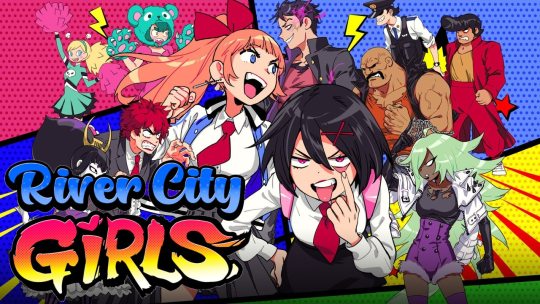
I love action games, but 2D beat-em-ups never really clicked for me. They were largely before my time and I was thinking that it’d be impossible to get me into one in the current era of gaming. And then I saw Marian’s redesign for River City Girls and bought the game. What can I say? Abs are a great sales pitch. But seriously, getting Wayforward on the helm of a beloved classic franchise is already a great way to pique my interest, and while there’s SOME aspects of this game that I don’t quite gel with, it’s a fun, colorful romp through a ridiculous universe that I’d LOVE to see more of down the line. Featuring a role-reversal, with the girlfriends saving the boyfriends this time, River City Girls has gorgeous pixel art, an AMAZING pop-synth soundtrack that’s worth the price alone, and it’s a game that clearly had fun with the concept and that fun rubs off on you. From the stylish animated boss intros, to the co-op fun that can be had with a friend, everything in this game is brimming with charm. Basic NPCs have great designs in their own right, being able to recruit enemies as assists is a neat idea, and it all adds up to a fun, bite-sized adventure with a bit of depth under the hood if you’re willing to give it a look. Can the character designers get a raise for this game, please? And let Megan McDuffie just do all the songs from now on. ALL OF THEM.
#9 - Astral Chain
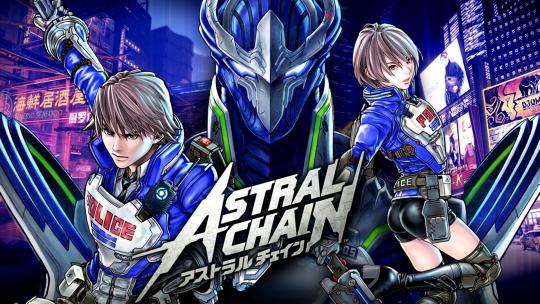
Most people assumed if we were going to get a Switch exclusive game by Platinum this year, it’d be Bayonetta 3 but instead Nintendo surprised us with Astral Chain, the anime cop action game we didn’t know we wanted. The game boasts great visuals and is probably the most content-rich Platinum game ever made for starters, but for me the true draw is in the combat. Playing as your police officer in tandem with an alien creature known as a Legion, this tag-team action game is unlike pretty much anything else on the market. While the game starts off very simplistic, the Legion itself moving and attacking with no input from the player, over time more and more options unlock and things get considerably more complicated. By game’s end, you’re drowning in options, and once things clicked, combat was always a treat. With plenty of enemies to practice with, Legions to master and a gigantic post-game filled with challenging encounters, I had more fun with the combat in this game than I did with a lot of other games this year. That said, I do feel that Astral Chain could have benefitted from trimming some fat or rethinking its overall structure. For being a new IP with some bold ideas, I’m willing to accept these as kinks that can hopefully be ironed out in a sequel. Oh, and add Lappy to Smash already. You know you want to, Sakurai.
#8 - BABA IS YOU
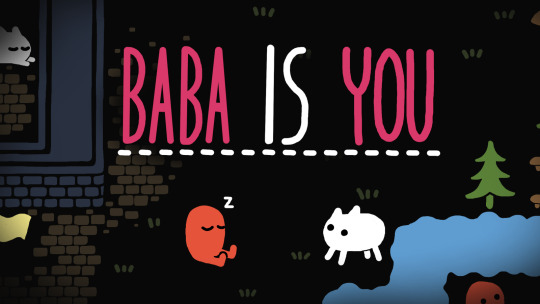
Puzzle games are hard sells for me, since I don’t like the frustration that often comes from being stuck. You feel dumb, you get embarrassed and turn the game off in shame, or at least that’s my experience. But then sometimes you get a game so clever, so…weird, that you can’t help but be sucked into it. BABA IS YOU is a block-pushing puzzle game, with the twist being that the “rules” of a particular stage are often physically present in levels and are in fact blocks that can be pushed and manipulated by the player. ROCK is PUSH, WALL is STOP, FLAG is WIN and BABA is YOU. But what if you can’t touch the flag because the wall is in the way? Well, make it so WALL is PUSH to move it aside, or maybe make it so that BABA is WIN and you become the win condition itself. As the game goes on, more modifiers and rules are slowly introduced and absorbed into your own internal logic of the game, logic that increasingly has to be broken and remade to suit your needs. It’s a very empowering experience when the solution clicks and the results can often be hilarious and surprising. This game also GOES PLACES the further you go in, and I’d rather not ruin that surprise for anyone who might be looking into the game. Definitely one of the most innovated titles I’ve played in a LONG time. BABA is GOOD.
#7 - Power Rangers: Battle for the Grid
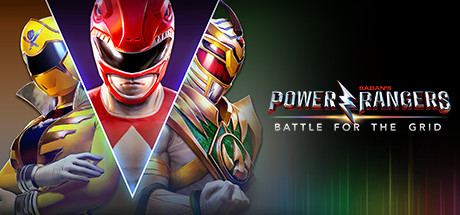
OK, so…hear me out. Power Rangers was a franchise I was obsessed with as a kid, and while I don’t follow it anymore, there’s still some love for it flowing in my veins. So when a small, no-name studio puts out a Power Ranger fighting game that takes the simplified controls of Smash Bros. and the tag-team craziness of Marvel vs. Capcom and slaps it all together for a cool twenty bucks or so? Well you got yourself a purchase and it ended up being WAY more fun than I expected. Power Rangers: Battle for the Grid is far from the best looking fighter on the market, it’s single-player content is lacking, and it’s roster, while interesting, isn’t as big as a lot of the competition, but damn if it isn’t fun to play. With characters taken from across the franchise’s long history, from the live-action movie reboot to the comic books, each choice has been inspired and resulted in an incredibly varied cast. With no crazy inputs for special moves, combined with a tagging system that lets you cycle through your three-Ranger team quickly, the game is the best kind of chaotic fun, but true masters can command that chaos and channel it into cool combos that make you want to say “Morphinominal!” Considering it’s a budget title, it’s also received a fair amount of updates throughout the year to pad out the roster with both free and paid DLC fighters, a full story mode and improvements to the netcode and overall presentation., so if you passed on it at launch, it’s much improved now. It’s not gonna be a fighting game on everyone’s radar, but I’d rather support it than the grind-heavy slog Mortal Kombat has become…Now just hurry up and add that monster that baked the Rangers into a pizza!
#6 - New Super Lucky’s Tale
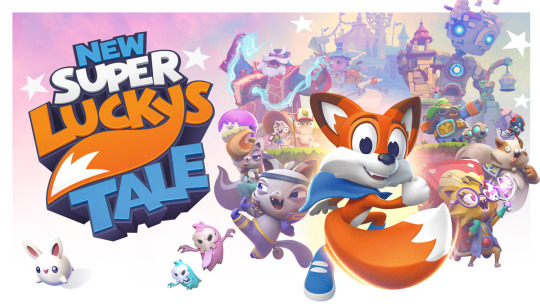
If your name isn’t Mario or Sonic, 3D platformers are effectively dead. That said, there’s been a few up-and-comers in recent years that are trying to revive the genre. Hat Kid from A Hat in Time, the duo of Yooka-Laylee, and now Lucky from the folks at Playful Studios. The cute fox has quite the history, starting from the Oculus Rift title, Lucky’s Tale, to a full-fledged platformer on the Xbox One X, Super Lucky’s Tale and now the enhanced port/reimagining New Super Lucky’s Tale on Switch. Halfway between a full-blown sequel, and enhanced edition, the game takes assets from the Xbox original game, tweaking and refining everything from visuals to controls to level layouts. The result is a game that is incredibly well-polished. It looks great, Lucky is a treat to control as he moves from jumping, burrowing and sliding around fluidly, and the variety on display keeps things interesting. We’ve got full 3D levels, 2D levels, auto-runners, and even some marble maze levels and puzzles thrown in for good measure. It’s not a hard game, but it IS incredibly fun, and well made. We don’t get many 3D platformers these days, so cherish what little comes of the genre. I hope Playful and Nintendo continue to collaborate, as they really seem more at home here. Just…maybe don’t add more words to the title of the next game, guys.
#5 - Katana Zero
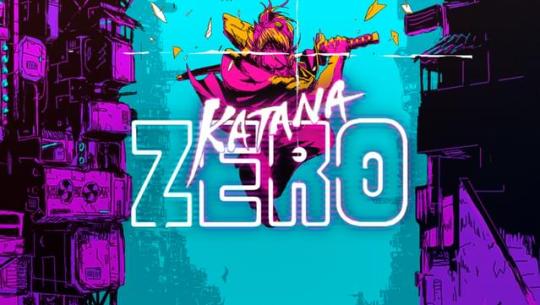
There’s no nice way to say it: there’s too many pixel-based, side-scrolling indie games out there, so the ones that DO stand out deserve to be celebrated. Katana Zero has a real ‘80s flair for starters, using bright neon, TV and VCR visual effects, and a synth soundtrack to give it some real style. When a game kicks off with you slowing down time and reflecting a bullet back at an enemy with your katana, you make a good first impression! Add in the trial-and-error that is planning the perfect route through a stage, the satisfying slicing and dicing of enemies, the unique, challenging boss encounters, and you have a game that was on my radar for a while, before I finally got into it at the end of the year. Its storyline is pretty interesting too, with some slight variances in how events unfold depending on your words and actions, though it ending on a bit of a cliffhanger is a bummer. That said, when a game leaves you wanting more, there’s worse problems to have. At the very least, there’s some DLC hinted at that might be interesting, as well as the implications that this is the merely the first in a trilogy, and at this point I’m game for whatever developer Askiisoft has in store.
#4 - Luigi’s Mansion 3
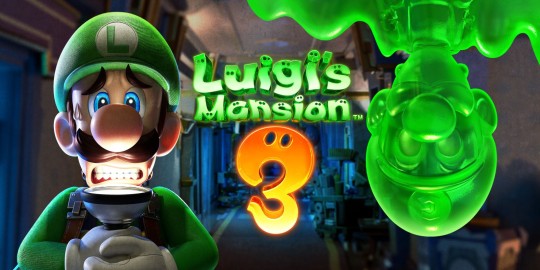
The GameCube was an odd era for Nintendo, as they attempted to innovate and try new ideas rather than rely purely on their old standbys. Case-in-point, rather than launch the console with a new Mario platformer, his second-banana brother Luigi got his first starring role in what would become the Luigi’s Mansion series. While not making QUITE as big of a splash as maybe Nintendo hoped, it’s garnered a decent fanbase, and when a sequel was announced for 3DS, people ate it up. Considering the gap between the first and second games, I think many people were surprised at the relatively quick turn-around for the third installment. I was also surprised at the overall quality and how much I enjoyed digging into it. For starters, Luigi’s Mansion 3 is easily one of the better-looking Switch titles, boasting some great lighting and particle effects, with some fun physics implemented for just about everything in the massive mansion. Luigi and company are animated with a lot of expressiveness that never gets old, and the music sets the tone perfectly too. From a gameplay standpoint, the toolset Luigi gains gives him ample options to poke at every nook and cranny, with the slimy doppelganger Gooigi being the clear stand-out. Some of the floors of the Last Resort hotel that Luigi must ascend are particularly massive and intricate too, some floors feeling like Legend of Zelda-style dungeons. While not a particularly challenging game, it’s still really satisfying to poke and prod at everything in sight, sucking in all the coins, gold bars and stacks of paper bills you can handle, not to mention slamming the ghosts around like the Hulk does to Loki. There’s also multiplayer! That I…haven’t really touched but…hey! More bang for your buck, surely!
#3 – Dragon Quest XI S
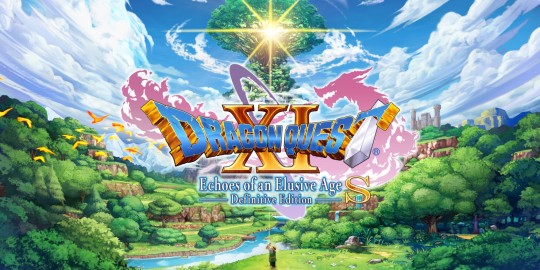
I don’t consider myself a huge fan of JRPGs. Or at least that’s what I thought before I tried out the Dragon Quest XI demo on Switch. I ended up falling for the game hard and bought the full release, carrying my demo data over and not stopping until I hit credits. Despite having never touched a Dragon Quest game before, outside of an hour or so of VIII, I was overcome with this feeling of nostalgia when it came to this game. That’s because Dragon Quest is THE quintessential JRPG game, the originator of all that we take for granted today. It was nice to feel right at home with a simple, effective combat system, rather than having to watch games re-invent the wheel in an attempt to stand out from the pack (sorry Xenoblade), and the story itself, while predictable and a little basic at times, was told well and told earnestly. It really nailed the feeling of going on a grand adventure, with enough twists on the formula to keep things interesting. The turn-based combat was elementary, but always presented me with fair challenges and lots of ways to solve the encounters laid before me, with enough quality-of-life features added in to minimize grind and make things more convenient. The Switch version of Dragon Quest XI featured a bunch of new content on top of a game that had more than enough going for it, and it’s clear a lot of work was done to make this port as faithful as could be, and it stands out not just as a great port on a system known for some shoddy ones, but as a title that’s brimming with as much polish and quality to rival first-party Switch titles. Don’t ban Hero in Smash and don’t miss out on this game if you haven’t taken the plunge already!
#2 – Devil May Cry 5

The Devil May Cry franchise has had its share of ups and downs over the years. For every game that’s considered a success, you have another game that doesn’t quite measure up. For years many thought the franchise was dead in the water after the attempted reboot, DMC: Devil May Cry failed to grow its audience, but when Microsoft’s E3 2018 show revealed to us a new installment, fans were ecstatic. Devil May Cry 5 boasts crisp visuals, deep combat and trims the fat, removing the wonky platforming and puzzles of earlier games to create a high-octane action experience that ultimately exceeded fan expectations. Its storyline firmly plants Devil May Cry 4’s Nero as a main character in his own right, wraps up the story of the Sparda brothers neatly, and if this ended up being the last title in the series, I think it’s that rare ending that ends up being totally satisfying. Combat is the real draw here though, the game giving players three distinct characters to learn and master. Nero’s robotic Devil Breaker arms allow him a decent amount of variety, while having a balanced, beginner-friendly combat style for new players. Dante remains the king of variety, having more weapons than ever before combined with his signature style switching, though the game is actually designed with all these options in mind so he doesn’t end up breaking the game like he did in 4. Newcomer V ends up being a breath of fresh air, controlling up to three demonic summons at once, forcing players to really think more strategically. The music is incredible too; Nero’s own theme, Devil Trigger, has been stuck in my head since last year and I don’t see it leaving any time soon. All things considered, Devil May Cry 5 might be the best game in the franchise, and a worthy contender for game of the year personally. Now if only we had a special edition with Vergil and the ladies playable…
#1 - Fire Emblem: Three Houses
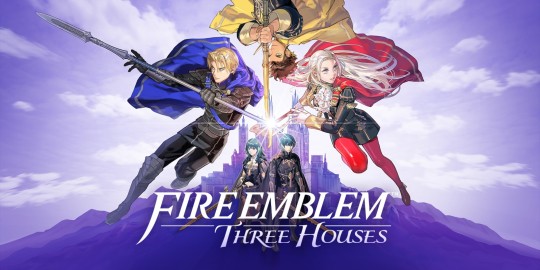
I got into the Fire Emblem series with Awakening and really liked it a lot, however Fates, the next installment, left a bad taste in my mouth. I couldn’t really get into Echoes, itself a remake of the second game in the series, and I began to wonder if this franchise was really for me. I was willing to give Three Houses a shot, but I was not prepared for the game to blow past all my expectations. Fire Emblem: Three Houses isn’t just a good game, it’s a game that’s redeemed a franchise that’s stumbled a bit in recent years, and it likely cements Fire Emblem as a core Nintendo franchise for years to come. It has class, depth and real heart...with only minor creepy or pervy elements! Making a grand return to home consoles after more than a decade on handhelds, it goes big and it ultimately paid off, on track to become the best-selling entry in the series. The school setting might seem weird at first, and I wondered how well I’d adjust to it, but being able to instruct your units and influence their growth in battle was worth the learning curve. Things are introduced slowly enough that the flow of the game becomes relatively easy to manage, if a bit time-consuming overall. With four distinct storylines you can explore, TONS of character interactions and some interesting tweaks to the strategic gameplay the series is known for, I’m confident in saying that Three Houses is well-worth a purchase for newcomers to the franchise. Divine Pulse is a great quality-of-life addition that lets you undo mistakes, rather than force you to start over from scratch, and overall the UI and layout of the game gives you enough information to make informed decisions without overwhelming you. Makes me wonder how we survived before the games showed us who enemies would target on their turns before now. Admittedly, some aspects of the progression have some issues, especially at endgame, and visually the game really is not up to par most of the time, but these end up being tiny blemishes in the long run for me. They certainly weren’t bad enough to prevent me from starting a new path the instant I finished my first route. If I have one request…just make Claude a gay option. Give the people what they want, Nintendo!
Honorable Mentions
I’d like to add on some honorable mentions here before we close things out, though most of these are things I didn’t even get a chance to play, but they certainly might have made this list. For one, Resident Evil 2 Remake seems like a high-quality reinterpretation of the survival-horror classic, but I can’t do horror so I’ll likely pass it up. It’s also for that reason that I might not get to Control but I might try jumping out of my comfort zone for that one. The confusion surrounding both The Other Worlds AND The Outer Wilds is funny, but they’re both space-based games I’d be keen on getting to at some point down the line; the former is a great Western RPG by the folks who made the GOOD Fallout games, while the latter is an interesting space-faring puzzler with some interesting mechanics I’d rather not spoil for those not more in-the-know. Indie titles Sayonara Wild Hearts and GRIS definitely caught my attention with their great visuals, and in the case of the former, its soundtrack, even if the gameplay wasn’t quite there for me, and the weird fighting-game-but-kinda-RPG that is Indivisible demands my attention sooner or later. Bloodstained is the Castlevania follow-up I keep forgetting is out, and I hear great things about Yooka-Laylee and the Impossible Lair. The team behind the Yakuza series recently made a spin-off of sorts, Judgment that hit the West this year and while I like the Yakuza series for its quirky tone and fun combat, there’s still six other games I’d have to sift through, so going with Judgment, which is set to possibly begin a new franchise, seems like a good alternative. And how could I forget the likes of Shovel Knight as we finally receive the last expansion that’s been years in the making? I haven’t touched the King of Cards expansion yet, but I have the upmost faith in anything Yacht Club makes, so that’s surely a game of the year contender. 2019 was crazy good! Glad to close the year out with so much quality, and tons of great stuff to add to the ever-growing backlog.
Hope you had some good gaming memories made this year!
-B
#gameoftheyear#GOTY#GOTY2019#astral chain#lucky's tale#baba is you#river city girls#devil may cry#luigi's mansion 3#katana zero#power rangers#fire emblem three house#dragon quest 11#xb-squaredx
1 note
·
View note
Text
A Hat in Time -- Cute as Heck
Yeah, I don't know where to start on this one. I mean I did liked Spyro: Year of the Dragon and that similar muppet video game when I was a kid. But I was never really into the 3D collect-a-thon, because the PS1 was the only console I had at the time, and most of those games were on the Nintendo 64. Hell, I didn't even know there was a Nintendo 64.
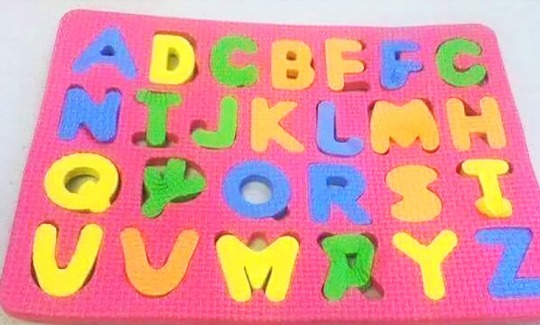
I told you, I was a dumb fuck when I was a kid
I picked this up because a friend kinda recommended it to me. I asked him about this game, and he said "it's pretty good, but the light-hearted-fun kind of good". Well shit, that's something I haven't heard in a long time to describe a video game, what with everything gotta be "gritty" and "realistic" but they end up edgy and depressing. After all of those things considered, I thought to myself, why not?
Let's have some light-hearted fun!
The first thing I noticed when I googled it is that it was a kickstarter project. I'm not gonna lie, I was kind of pessimistic. What, with your Mighty No. 9 and Yooka-Laylee ending up being one of the most expensive disappointment in the history of kickstarted games. But between the two, Mighty No. 9 was the one that caught my attention the most. I mean Keiji Inafune was in the team behind it. And that guy was the father of Megaman. This is like if BombTag was made by the guys who made Bomberman but also being a lot more shit than the current version of BombTag. So you can clearly see why it was a cruel twist of fate that it turned out to be crap, it had all the pieces and all the money it needed to be the homecoming diva of the year that will receive all the scholarships, and look how it ended up: a 60-pound crack-whore that sucks dick by the nickel. Well I decided then that wallowing and speculating about how this game might be another pile of shit is just wasting my goddamn time, so I moved on to finally playing the game.
The first time I started it, I wasn’t impressed
I’m just gonna be honest and upfront about this, I think the graphics sucked. I understand that you’re angry, but this is my paragraph, so shut the fuck up. Ok, how do I explain this? I mean the graphics are cel-shaded, which actually compliments the theme this game was going for, I’ll give it that much. But it’s fucking bad, even for indie. There are clipping issues everywhere, shading that went crazy and mis-matched, and a few more minor issues. They didn’t disturb the game though, not at all. I just think that if you’re making a game that’s on kickstarter and a few projects like this one has failed miserably, maybe don’t make it look like Wind Waker went a few rounds with a semi truck. But again, as I have said, it does not affect the game in any way, just a minor complaint from me really. The graphics aren’t the strength of this game anyway.
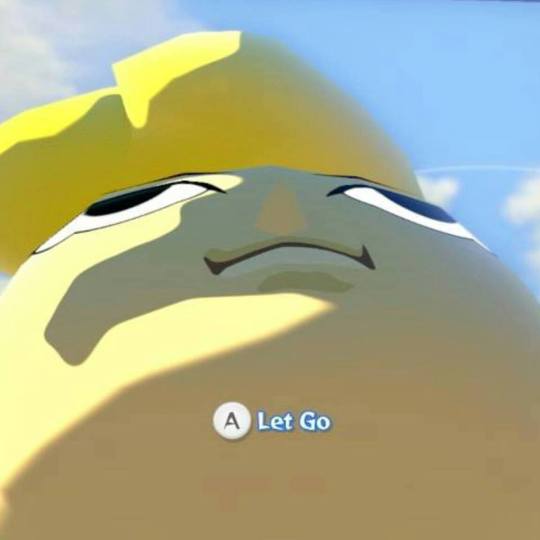
To be fair, graphics wasn’t Wind Waker’s strong suit either
To me, the strength of the game lies in the gameplay
The story is that you are some alien kid in a spaceship fueled by thingies called Time Pieces. On your way home some mafia guy asked you to pay the toll, in a blue suit, in outer space, without rockets. You gotta admire his dedication. Anyway, he fucks up your ship and as a result all your time pieces got scattered across different themed worlds. And thus begins your journey of collecting all 40 macguffins so you can kickstart your magic spaceship-home-base-thingy! Now please relocate your eyes back to it’s original place after rolling it so far backwards from hearing the sub-par theming of the game. Don’t worry, I promise everything gets better, because I will finally talk about the gameplay in the next paragraph
The gameplay at it's core is a simple 3D platformer. You jump, you slide, and you attack enemies. Pretty basic shit on the surface level, if not deceptively so. Thing is, there are moves that you can get from a combination of jumps, slides, and wall hops that can get you further than your little minds can handle. And like it or not, this is a thing that you have to master becuase the platforming will only get more and more challenging as you progress throuh the levels, especially the secret levels that can be hard as balls. Thankfully, they usually teach you how to do things by introducing a mechanic in a story first, and only after then do they allow you to go wild.
The second part of the gameplay is the objective, which is to collect all the scattered time pieces thingy to re-fuel your spaceship. This is achieved through a set goal depending on the levels of the game. And since there are 5 unique worlds in total, each with levels of their own, you can bet your ass that there’s a lot of gameplay variety. This is in one hand, a good thing since a lot of variation can be a guarantee that you will not get bored by doing the same thing again and again. I guess this is a thing that comes from being a kickstarted game. This dev guy wants this, that dev person wants another thing, and the everybody just frankenstein’d all the different concepts into one big ball and hope for the best. Thankfully, it worked in favor of the game, since the interchanging themes and mechanics means that every level feels fresh and novel. Although I must say, this also results in one particular level that’s very different in tone from the rest of the levels. I mean for comparison, In one level I was in a town full of bald Mafia men, pushing them off cliffs and ledges for fun. Meanwhile, in the next level I was being chased by the lordly ghost woman in a haunted mansion. Now, since the other levels are anything BUT scary, I thought that this horror-themed level is just children level of scary. You know, like your talking bones or bed sheet ghosts. What I didn’t expect was a sincerely terrifying level that made me genuinely scared.

Wow, I never expected that my pants could be so brown.
I gotta tell you though, that level wasn’t some kind of genius design or some avant-garde breakthrough. It’s just your generic scary enemy chasey chasey sequence you’ve seen a million times. It’s just that you can really feel the horror because you didn't expect it to be there. It’s like walking into Disneyland to find everything has been replaced by spiders and mickey had hung himself on the main attraction.
One thing that I felt is that the game is very short. 25 levels in total (excluding the DLC) with bonus missions for extra time pieces that amounts to 40. That may seem to be a huge number, but trust me it isn’t. The reason why is because the game is a bit of a cakewalk. The bosses themselves aren’t hard, except for the purple ghost guy that can spam AoE attacks like it’s going out of style. After playing it fully, I get the feeling that I’m not quite the intended audience for this game. I feel like A Hat in Time is made to be played by children. It’s just a feeling I had though.
In Brief
You know what I felt when I played A Hat in Time? Joy. Pure innocent child-like joy that leaves a grin on your face. The kind of grin you used to get when you played in the yard with your friends or family. It’s a different kind of joy from the triumph when you defeat a hard boss in Dark Souls or when you get the top frag in shooter games. It’s warm and optimistic and leaves you content. If you’re a kid looking for a good kiddie game, this one’s for you. If you’re just looking for some good old fashioned nostalgic platformer game, this one’s also for you.
Hey we don't judge things over here my guy. A game's a game, and what matters is you enjoy what you're playin'.
1 note
·
View note
Text
Modest Media Game Reviews Ninja Gaiden

Game – Ninja Gaiden Year of Release – 1988 (JP) 1989 (US) Developer – Tecmo Publisher - Tecmo Rated – Pre-Dates ESRB Genre – Action Side scrolling Platformer Platform - Nintendo Entertainment System, TurboGrafx-16, Super Nintendo Entertainment System, Wii Virtual Console, Mobile phones, 3DS Virtual Console, Wii U Virtual Console
Ninja Gaiden is often referred to as one of the most insanely difficult games on the NES. A super challenging side-scroller platformer that has been simultaneously loved and criticized by fans and critics alike. Can a game be too hard for its own good? Lets find out.

Gameplay – To answer the previous question, yes, yes you can. This game’s difficulty is unfair and unbalanced. I am not saying its bad, but ill cover why it is unfair. First of all, enemies, they are the bane of this game. Enemies tend to spawn out of nowhere and in later levels spawn in such a way its almost impossible to avoid getting hit. This is best seen with the room before the final boss, where enemies rain from the ceiling and just try to hover over you while knocking you back and forth. Due to this game’s wonky respawn system, enemies immediately respawn when offscreen, and enemies that fly from the corner of the screen can appear infinitely. Look no further than the infamous birds for this example. Some enemy layouts are so complicated or so unfairly placed that its almost pure luck if you can escape. A good example is this one point in the final level where dozens of flying ninjas at various speeds and elevations bombard you while you platform, and due to the way enemies respawn, the bombardment never ends. Now with the negative out of the way, lets look at the positive. Level layouts are alright, straightforward and standard. Some of the games more infamous moments are only found late in the game regarding level layout. The cliffside is without a doubt the worst level. However, there are some good levels in there as well, the first level does a great job weaning you into the games style. Though it’s a rocky road from there. Some of the platforming feels stiff and Ryu lacks some mobility regarding his wall jumping, its easy to get stuck on a top of a wall and get hit, or an enemy might just decided to stand at the edge and make it a pain to progress. Ryu fights with a sword, meaning all foes must be very close to damage, various other things, like shuriken or fire balls appear in limited qualities. The extra tools can make certain parts a bit easier. Bosses in this game are a mix bag but are not overly difficult with two exceptions. The last 2 bosses, being Malth and the final boss room, are painfully difficult. Most of their moves seem unavoidable and losing to them means replaying some of the hardest levels in the game! I cannot give this game a very high score in this department, its not bad, but it is to frustrating and hard to be enjoyable. Please note that I did beat the game, so I’m not just moaning over not being able to beat it. Score – 12/20
Graphics – Pretty good. Each level has a color scheme that, while not realistic, is a constant. Ryu and the enemies don’t clash with the background, so you will see enemies on the screen along with interactable torches that could be hit for points, health or weapons. There are many enemy types, and the game can handle a lot of character movement at once. The cutscenes between levels look great for their time and are inspired by anime from the 80s. While some levels can feel dull or look boring, the games overall graphical presentation is up to par. Score – 8/10
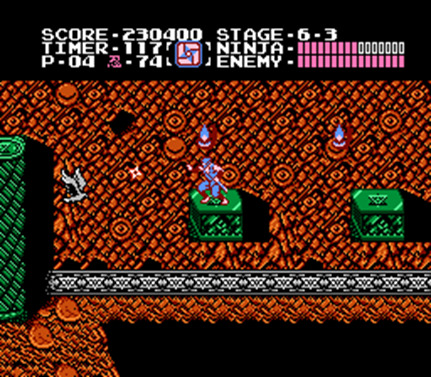
Story – For a game from the 80s, where story was usually locked in the pages of a manual, Ninja Gaiden does tell a story. While this story, if told nowadays might better fit a cartoon than a game made to be taken seriously, it works really well. Ryu’s father is supposedly killed in combat, and Ryu, armed with the dragon sword seeks revenge. Ryu is hunted by the CIA, whom try to force him to help overthrow a cult trying to revive a demon. There is a romantic subplot…kind of. There is a plot point about Ryu’s father and of course there is the evil demon and the cult leader revealing his evil plans. Overall the plot is nothing special and again by today standards, it would be considered cliché. This was the 80s though, so this could be one of the most enticing game stories of the time. Couple this with the aforementioned cutscenes and you have a good solid plot. The game also leaves room for a sequel as well, but that’s a review for another day. Score – 7/10
Replay Ability – Low, there are no secrets in this game nor any elements in the game that are introduced in a subsequent playthrough. While some people speed run or try for high scores, the general audience might try it and put it down. Unless it is for nostalgia reasons of course. Given this games brutal nature, I think one playthrough will suffice all but the hardcore Ninja Gaiden fans. On the plus side, it is short enough to not eat up a day…if the player in question is good at it. Score – 2/5
Music – Pretty good! The majority of the ost is somewhat techno and upbeat. The music compounds the gameplay by being fast paced and organized yet hectic as well. Even though there is not much diversity in music, each level has its own theme. While it may sound repetitive in some cases, it is enjoyable nonetheless. Sound effects are alright, the main sound effects you will be hearing is the sound of the sword swinging and the sound of an item being picked up. I would recommend giving the ost a listen to. Score – 4/5
youtube
Overall – This game is hard, so hard that it negatively impacts the quality of presentation. While this game shines in other forms of presentation, it is the fundamental gameplay that undoes it all. There is a difference between fair and balanced hard and unfair hard. Unfortunately, a lot of old school hard games had this more unfair spike to it. Now, I think this game is flawed, yes, but its not that bad. It is frustrating but competent with level design for the most part. If you are looking for a hardcore challenge, then this is a game worth trying, but if you want a genuine tough but manageable old school Nintendo game, look elsewhere. Final score – 6.6/10 – so - so
#Modest Media Review#game#video games#game reviews#nintendo#nes#famicon#tecmo#1988#1989#virtual console#wii#wii u#ds#ninja gaiden#ninja
4 notes
·
View notes